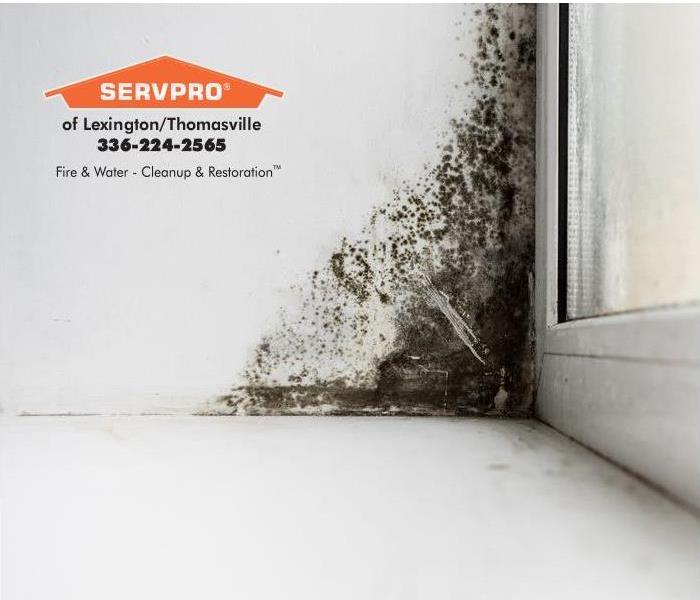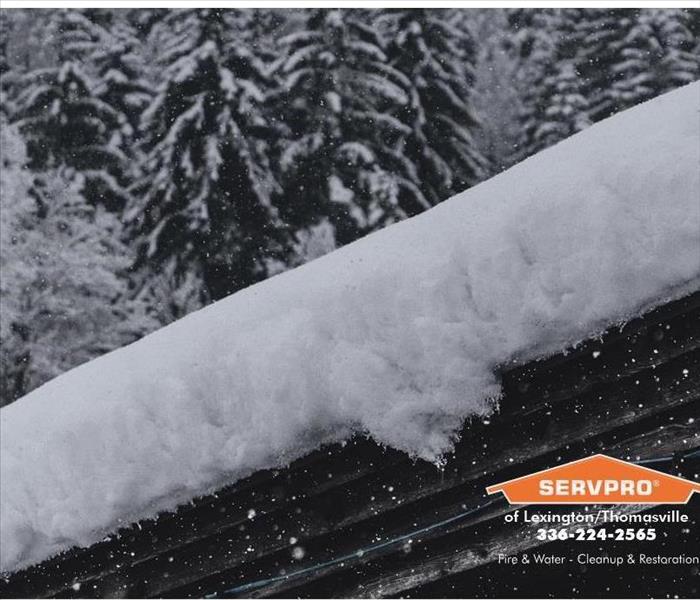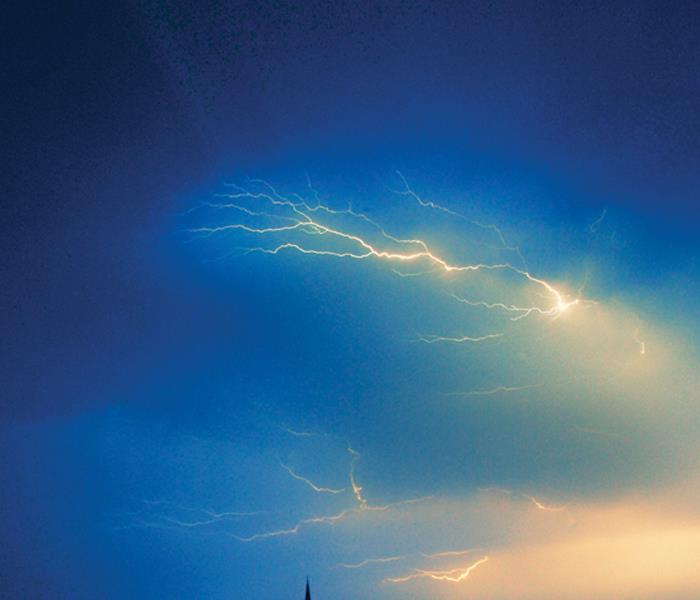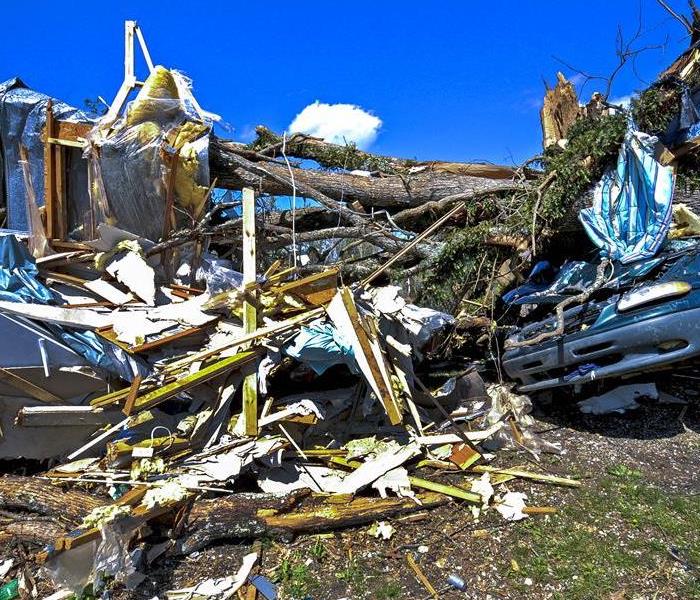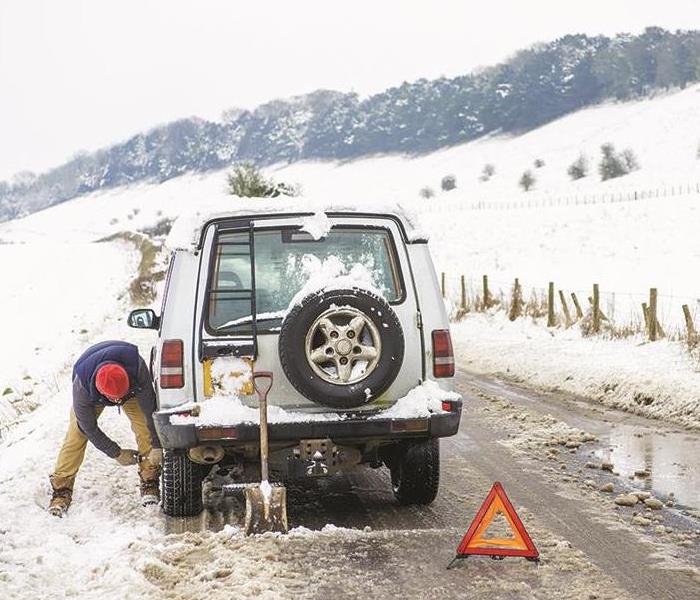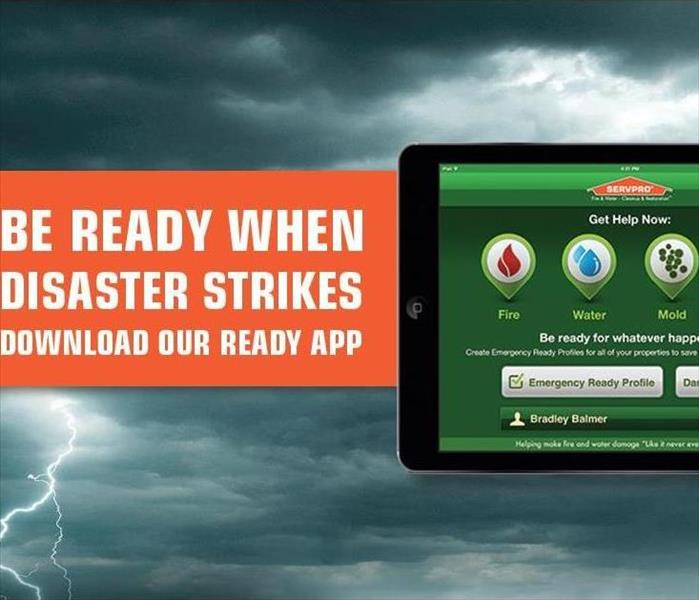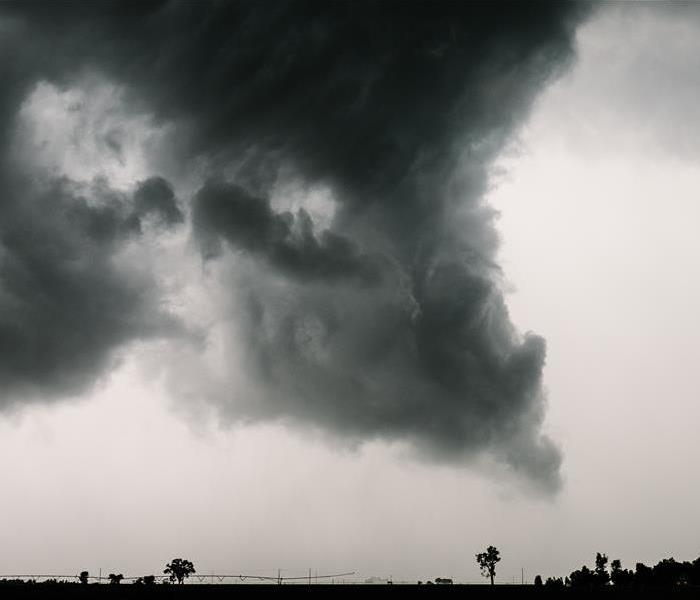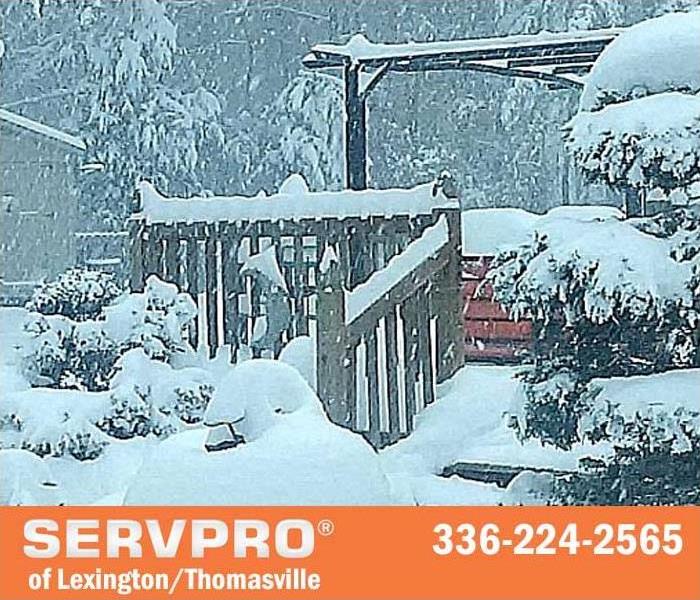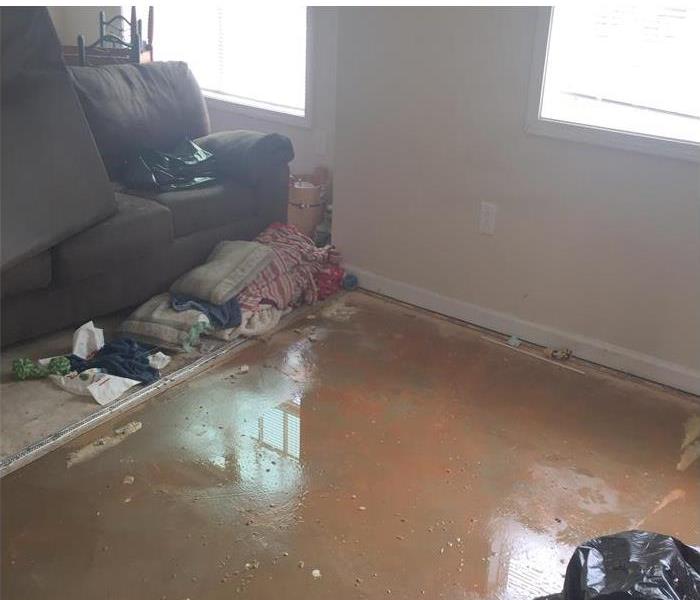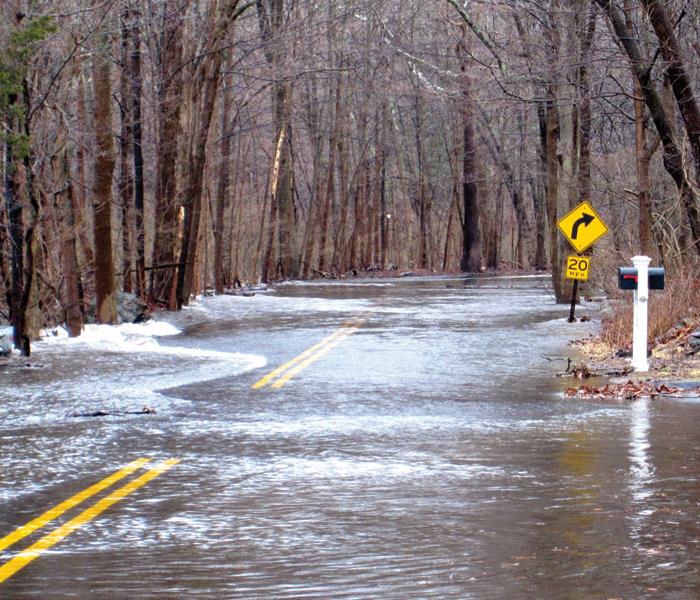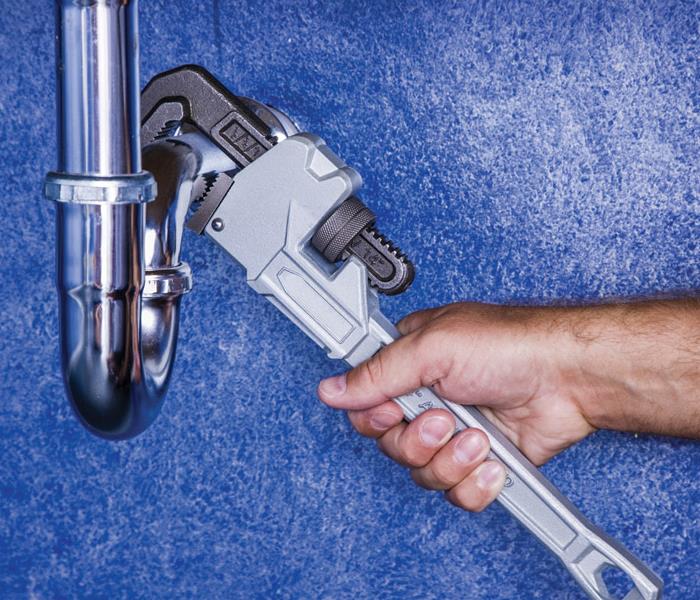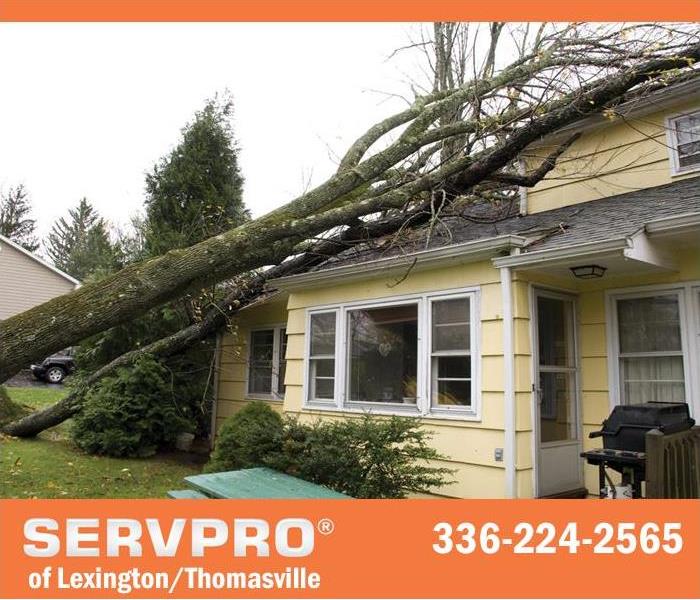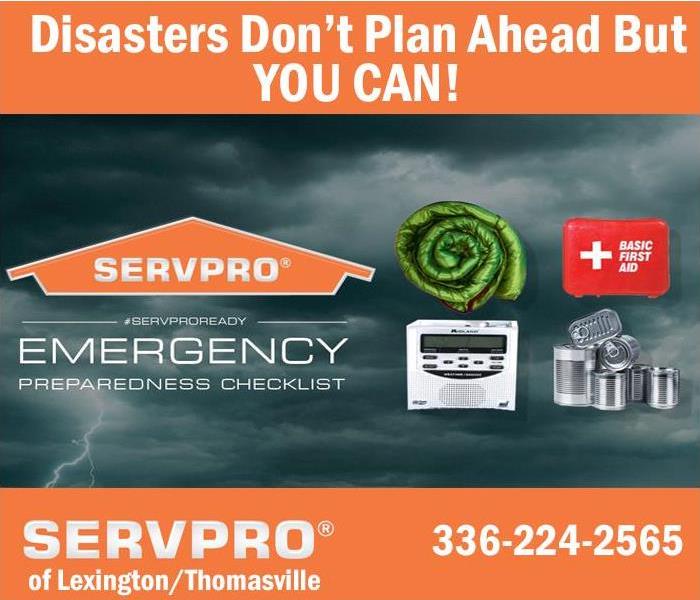Archived Storm Damage Blog Posts
How to Safely Use Candles and Alternative Lighting during Power Outages
1/17/2024 (Permalink)
Power outages, whether caused by storms, natural disasters, or technical issues, are an eventuality that we occasionally grapple with. In times like these, candles often become our primary light source. Here at SERVPRO of Lexington/Thomasville, your go-to professionals for damage cleanup and restoration, we always advocate for safety first. That's why we've written a blog tackling the essential tips for safely using candles and investigating other alternative lighting you can use during power outages.
Safe Candle Usage: Light the Way Responsibly
Candles, with their flickering flames, offer more than just illumination; they provide comfort in the dark and an ambiance all their own. However, it's essential to remember the potential fire risk that they pose.
- Don't Leave Candles Unattended: Always be vigilant. Blow out candles before leaving the room, going to sleep, or if the flame becomes too high.
- Keep Flammables at Bay: Ensure that candles are placed well away from flammable objects such as curtains, books, paper, and fabric.
- Use a Stable Holder: Always use a sturdy candle holder placed on a stable, heat-resistant surface to protect against potential wax spills or accidental tip-overs.
- Keep Out of Reach: Place candles out of the reach of children and pets to avoid accidental burns or fires.
Alternative Lighting Options: Safety with Innovation
Let's explore some safer alternatives to candles when the power goes out:
- Battery-Powered Lights: Battery-powered lamps, lanterns, or even LED strip lights are safe, effective, and provide substantial illumination for indoor spaces.
- Flashlights and Headlamps: Keep a good stock of flashlights and headlamps—along with plenty of spare batteries. They're safe, portable, and ideal for focused, directional lighting.
- Solar-Powered Lights: Outdoor solar lights can be brought inside after dark to provide several hours of illumination.
Here at SERVPRO of Lexington/Thomasville, we strive not just to restore your homes and businesses post-disaster but to equip you with the knowledge to prevent them. By using candles and alternative lighting sources safely during a power outage, we can minimize the risk of fire and related damage.
However, if an unfortunate event does occur, remember that our team of experts is always ready to provide swift, professional cleanup and restoration services. Serving communities around the clock, we bring the comfort of making damage "Like it never even happened."
6 Essential Steps to Prepare Your Home for Severe Weather
10/5/2023 (Permalink)
Storms can be unpredictable and wreak havoc on your home, especially in a state like North Carolina, where severe weather events are all too common. Preparation is key to protecting your property and ensuring your family's safety during storms. In this blog, we'll walk you through six essential steps to prepare your North Carolina home for storms. By following these guidelines, you can minimize damage and stay safe when Mother Nature unleashes her fury.
1. Create an Emergency Kit
Every North Carolina household should have an emergency kit ready. Include essential items such as non-perishable food, bottled water, a flashlight, batteries, a first-aid kit, important documents, and medications. Ensure your kit is easily accessible, and periodically check and update its contents.
2. Secure Outdoor Items
Strong winds during storms can turn outdoor objects into projectiles, causing damage to your home and posing a danger to your family. Secure or bring items like patio furniture, grills, toys, and garden decorations indoors. Trim overhanging tree branches that could fall during a storm.
3. Reinforce Windows and Doors
Protect your home from high winds and flying debris by reinforcing windows and doors. Install storm shutters or use plywood to cover windows. Ensure that all exterior doors are in good condition and have secure locks. Consider impact-resistant doors for added protection.
4. Inspect and Maintain Your Roof
A well-maintained roof is your first line of defense against water damage. Regularly inspect your roof for loose or damaged shingles and repair them promptly. Clear gutters and downspouts to prevent water backup during heavy rains.
5. Backup Power Source
Power outages are common during storms, so having a backup power source is crucial. Invest in a generator that can keep essential appliances running, like refrigerators, heating, and medical equipment. Make sure you know how to use it safely.
6. Plan an Evacuation Route
In some cases, it may be necessary to evacuate your home during severe storms, especially in coastal areas. Plan an evacuation route in advance and share it with your family. Pack essentials and consider your pets' needs when planning your evacuation strategy.
Preparation is key to safeguarding your North Carolina home and family from the unpredictable nature of storms. By following these six essential steps, you can be better equipped to face the challenges that severe weather can bring. Remember that SERVPRO® of Lexington/Thomasville is here to help you recover if your home does suffer storm damage. Stay safe, stay prepared, and stay resilient in the face of North Carolina storms.
SERVPRO of Lexington/Thomasville is prepared to handle #anysizedisaster!
6/19/2023 (Permalink)
 SERVPRO of Lexington/Thomasville Storm Response Team
SERVPRO of Lexington/Thomasville Storm Response Team
SERVPRO of Lexington/Thomasville's Storm Response Team are a highly trained and experienced group of professionals who are ready to respond to any storm-related emergency. We have the expertise and equipment necessary to handle everything from minor water damage to major flooding and storm damage. Our readiness is unmatched, with a 24/7 emergency response team that is always on call and ready to spring into action at a moment's notice.
When it comes to storm response, SERVPRO of Lexington/Thomasville is second to none. We have a comprehensive approach to storm damage restoration that includes everything from initial assessment and cleanup to complete restoration and reconstruction. Our team is equipped with state-of-the-art equipment and technology, including moisture meters, air movers, and dehumidifiers, to ensure that every job is done right the first time.
In addition to our expertise and equipment, SERVPRO of Lexington/Thomasville's Storm Response Team is also committed to providing exceptional customer service. We understand that dealing with storm damage can be a stressful and overwhelming experience, and they work hard to make the process as smooth and stress-free as possible. We are always available to answer questions, provide updates, and offer guidance throughout the restoration process.
Overall, if you're looking for a reliable and experienced storm response team, SERVPRO of Lexington/Thomasville is the way to go. With our expertise, equipment, and commitment to customer service, you can rest assured that your storm damage restoration needs will be taken care of quickly and efficiently.
What Can Storms Do to Your Home? How Can You Prevent Damage?
5/20/2023 (Permalink)
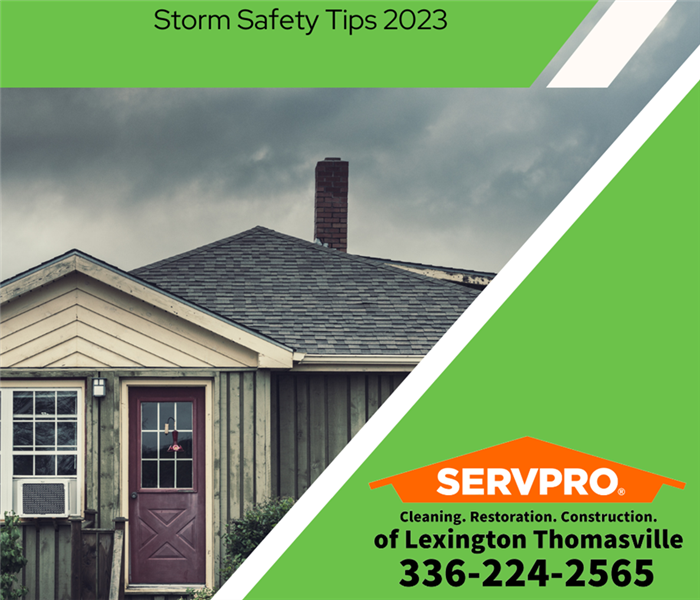 What Can Storms Do to Your Home?
How Can You Prevent Damage?
What Can Storms Do to Your Home?
How Can You Prevent Damage?
What Can Storms Do to Your Home? How Can You Prevent Damage?
When a storm hits, it can cause much damage to your home. From strong winds to heavy rain, storms can wreak havoc on your property and cause significant structural damage.
Some of the damage that can be done to your home during a storm include:
- Roof damage:
- Strong winds can cause shingles to blow off your roof, exposing it to water damage. This can lead to leaks and further damage to your home's interior.
- Water damage:
- Heavy rain can also lead to water damage inside your home, especially if your roof is damaged or your gutters are clogged.
- Debris damage:
- Flying debris during a storm can cause damage to your windows, doors, and siding.
- Electrical damage:
- Lightning strikes can cause electrical damage to your home and appliances.
- Power surges can also occur when power is restored after a storm.
- Foundation damage:
- Heavy rains and flooding can cause foundation damage to your home's structure.
So, what can you do to prevent damage to your home during a storm? Here are some tips:
- Regular maintenance:
- Regularly maintaining your roof, gutters, and windows can prevent damage during a storm.
- Make sure to clean your gutters and remove any debris that might clog them.
- Reinforce your roof:
- You can reinforce your roof with materials like hurricane clips and straps to prevent damage during high winds.
- Seal your windows and doors:
- Sealing your windows and doors can prevent water and debris from entering your home.
- Install surge protection:
- Installing surge protection can help prevent electrical damage during a storm.
- Elevate your home:
- If you live in an area prone to flooding, elevating your home can help prevent foundation damage.
By taking these steps, you can help prevent damage to your home during a storm. However, if your home does sustain any damage, it must be professionally inspected and repaired as soon as possible. A quick response can help prevent further damage and ensure the safety of your home and family.
SERVPRO of Lexington/Thomasville is available 24 hours a day, seven days a week, 365 days a year. We are #fastertoanysizedisaster and make any disaster #likeitneverevenhappened. We are backed by 50 years of training and experience through our parent company SERVPRO. We are locally owned and operated and are active community members. Give us a call for any of your storm damage needs. 336-224-2565!
Storm Preparation: How to Stay Safe and Be Ready
5/8/2023 (Permalink)
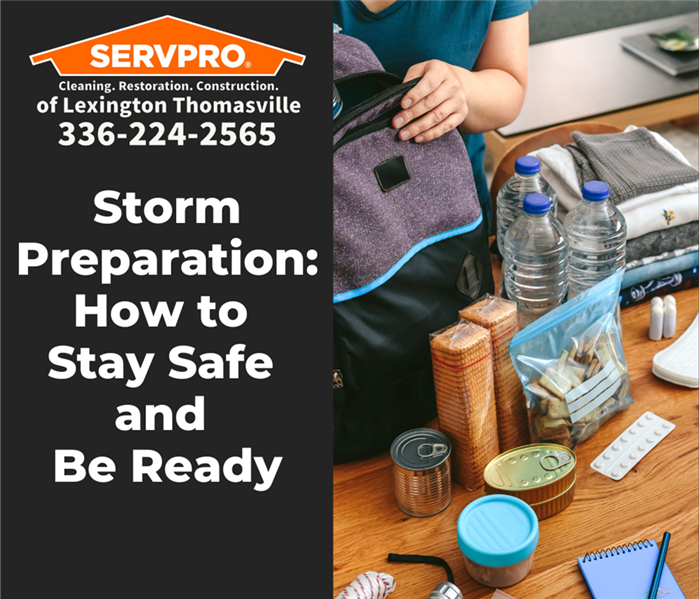 Storm Preparation: How to Stay Safe and Be Ready
Storm Preparation: How to Stay Safe and Be Ready
Storm Preparation: How to Stay Safe and Be Ready
Natural disasters like storms can strike at any time, so it is important to be prepared and stay safe. With proper preparation, you can minimize the damage to your property and protect your family during a storm.
Here are some tips to help you prepare for the next storm:
- Create an Emergency Plan
- Before a storm hits, create an emergency plan for your family.
- This plan should include communication and evacuation procedures.
- Make sure everyone in your household knows what to do in an emergency and where to meet if you are separated.
- Stock Up on Supplies
- Make sure you have enough food, water, and medical supplies to last at least three days.
- Stock up on batteries, flashlights, and other emergency supplies.
- It's also a good idea to keep a supply of cash on hand, as ATMs and credit card machines may not be available during a power outage.
- Protect Your Home
- Inspect your home to ensure that it is structurally sound and can withstand high winds and heavy rain.
- Trim trees near your home to prevent them from falling onto your roof, and clear gutters and downspouts to prevent flooding.
- Cover windows and doors with hurricane shutters or plywood to protect against flying debris.
- Stay Informed
- Stay informed about the storm by monitoring local news stations and weather apps.
- Follow instructions from local authorities and evacuate if instructed to do so.
- If you cannot evacuate, stay indoors and away from windows and doors.
- After the Storm
- After the storm has passed, inspect your property for damage.
- If you have suffered damage, contact your insurance company, and begin filing a claim.
- Take photos of the damage for documentation purposes.
- Call SERVPRO of Lexington/Thomasville at 336-224-2565.
- We will work directly with the insurance adjuster and help make the claims process more manageable, allowing you to get back into your home in the condition #likeitneverevenhappened.
- We are #fastertoanysizedisaster and take pride in treating our clients like family.
- We are locally owned and operated and are available 24 hours a day, seven days a week.
- There is no job too big or too small for us to handle!
In conclusion, preparing for a storm is essential for staying safe and minimizing damage. Following these tips can help protect your family and your property during a storm.
SERVPRO of Lexington/Thomasville is recognized as a Storm Team, and we are equipped to handle all storm damage cleanup and restoration aspects.
4/20/2023 (Permalink)
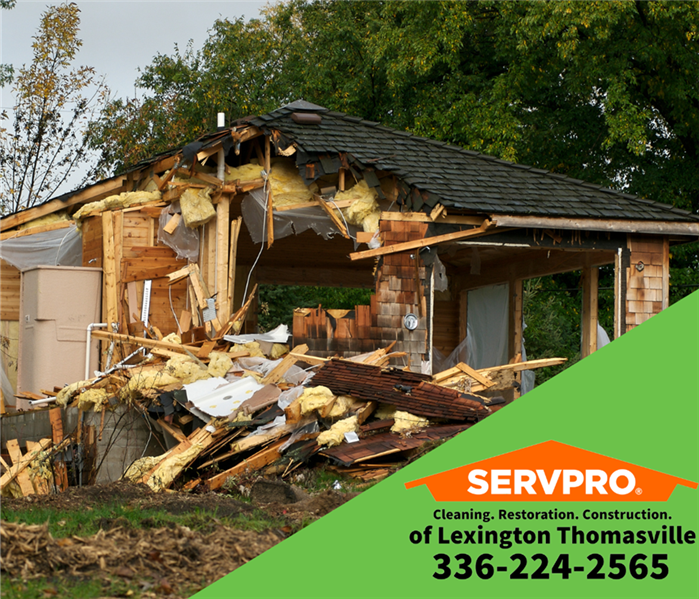 SERVPRO of Lexington/Thomasville is recognized as a Storm Team, and we are equipped to handle all storm damage cleanup and restoration aspects.
SERVPRO of Lexington/Thomasville is recognized as a Storm Team, and we are equipped to handle all storm damage cleanup and restoration aspects.
When a storm hits and causes damage to a property, it can feel overwhelming and chaotic. Fortunately, SERVPRO of Lexington/Thomasville is recognized as a Storm Team, and we are equipped to handle all storm damage cleanup and restoration aspects. Our company’s trained technicians are available 24/7 to help people recover from the impact of a storm.
Here are a few ways that SERVPRO of Lexington/Thomasville assists with storm damage:
Emergency Response:
SERVPRO of Lexington/Thomasville understands that storms can hit unexpectedly and require a quick response. When you call SERVPRO, a trained technician will arrive on-site as quickly as possible to assess the damage and start the cleanup process.
Water and Flood Damage Restoration:
Storms can cause flooding or water damage to properties. SERVPRO of Lexington/Thomasville has the equipment and expertise to extract water, dry the area, and prevent mold growth.
Tree Damage:
When trees or large branches fall on a property and cause damage, SERVPRO of Lexington/Thomasville can remove the debris, repair the structure, and prevent further damage.
Roof Repairs:
Storms can damage roofs, potentially creating leaks and causing further damage to the property. SERVPRO technicians can repair or replace damaged roofs to prevent further water damage.
Document Restoration:
Storms can also damage important documents, photographs, or books. SERVPRO of Lexington/Thomasville has specialized equipment and techniques to restore and preserve damaged items for future use carefully.
SERVPRO of Lexington/Thomasville has extensive experience restoring residential and commercial properties that have experienced storm damage. No matter how big or small the project is, SERVPRO of Lexington/Thomasville is committed to restoring the property to pre-storm condition as quickly and efficiently as possible.
Storm Damage Restoration: Here to Help
2/16/2023 (Permalink)
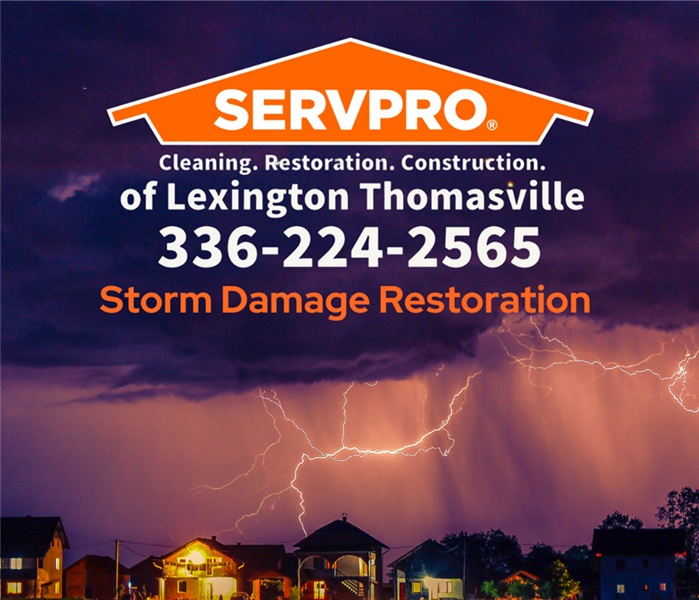 SERVPRO of Lexington/Thomasville Storm Damage Restoration
SERVPRO of Lexington/Thomasville Storm Damage Restoration
When storm damage strikes, we know and understand that every second matters. We also know that a quick response time is essential to help prevent secondary damage.
That's why SERVPRO of Lexington/Thomasville's professionals are faster to any size disaster. No matter the extent of damage, we can handle it. No job is too big or too small for our experienced storm damage restoration professionals.
SERVPRO of Lexington/Thomasville is here to help our local communities in the event of storm damage. We are also here to help other communities. And we have been there to help other communities when they face storm damage. Our professionals assisted with the storm cleanup in Kentucky following freezing temperatures that caused many home and business owners' pipes to freeze and burst. SERVPRO of Lexington/Thomasville's professionals also assisted with Hurricane Ian.
SERVPRO's Disaster Recovery Team® has responded to a myriad of other significant loss and storm events across the country, including:
• 2022 Hurricane Ian
• 2022 Hurricane Nicole
• 2021 Winter Storm Uri
• 2020 Hurricane Laura
• 2019 Hurricane Dorian
• 2018 Camp Wildfire
• 2018 Hurricane Michael
• 2018 Hurricane Florence
• 2017 Hurricane Irma
• 2017 Hurricane Harvey
• 2016 East Tennessee Wildfires
• 2016 Hurricane Matthew
• 2016 Louisiana Flooding
• 2016 Houston Flooding
• 2015 Siberian Express
• 2014 Mid-Atlantic Flooding
• 2014 Polar Vortex
• 2013 Colorado Floods
• 2013 Alberta, Canada Floods
• 2012 Hurricane Sandy
• 2012 Hurricane Isaac
• 2011 Hurricane Irene
SERVPRO professionals helped restore those communities to make the damage "Like it never even happened." We've been there for millions of families during storm events, and we'll continue to be there for them should they face any in the present or future. You never know when storm damage can strike, so it's good to know how to prepare and recover from hurricane damage.
Our highly trained professionals are nearby to come to your family's rescue. In the aftermath of storms, our state-of-the-art equipment and tools help remove all water from your residential property to help avoid and prevent secondary damage. And this helps ensure you and your family are safe. SERVPRO of Lexington/Thomasville's professionals will help restore your home to preloss condition.
SERVPRO of Lexington/Thomasville's professionals focuses on you and your family, returning your home to a preloss state as quickly as possible. The best action for a storm disaster is to prepare, and SERVPRO of Lexington/Thomasville is fully prepared and equipped. Because, as you know, Mother Nature can occur at any given moment, and the aftermath can be devastating and life-altering. Suppose your family is ever affected by storm damage. In that case, you can have assurance knowing that SERVPRO of Lexington/Thomasville is here to help you and your family in your time of need.
Staying safe during storms and tornadoes
8/17/2022 (Permalink)
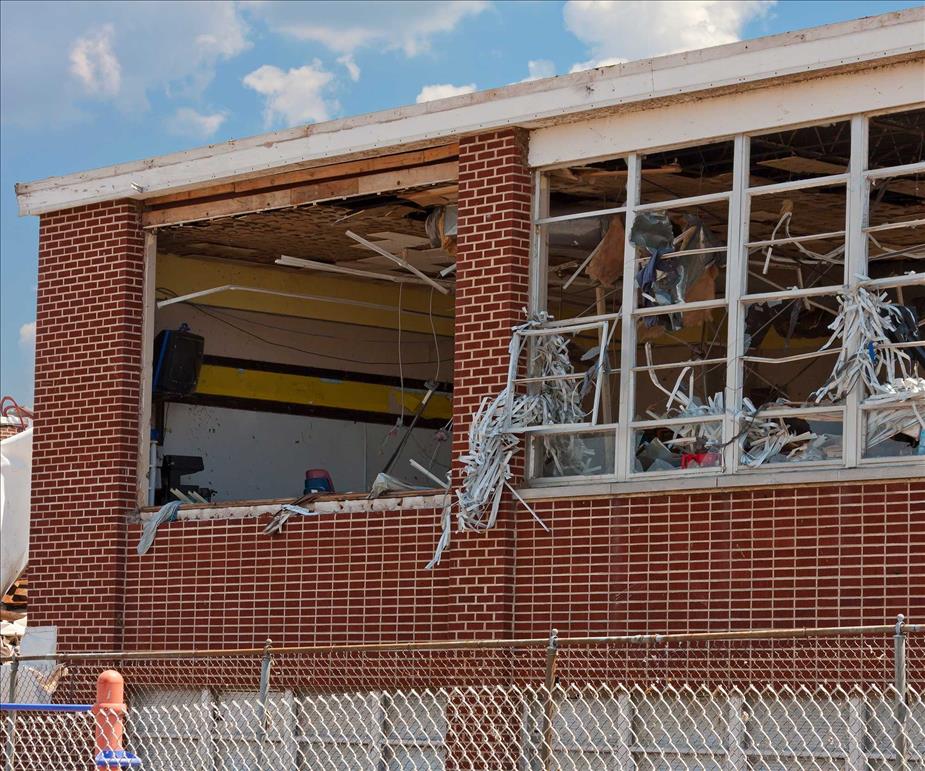 Building severely damaged by a Tornado.
Building severely damaged by a Tornado.
Tornadoes can strike with little to no warning if conditions are favorable. Tornadoes tend to occur in specific regions but it’s important to remember they have occurred in all 50 states and can happen any time of year. We often hear about the Fujita Scale rating, which measures the severity of wind speed; F1 tornadoes are the weakest, and F5 tornadoes are the strongest. Still, F1 tornadoes remain very dangerous, so during storm season, it’s prudent to remain prepared, especially if you live in an area prone to tornadoes and intense thunderstorms. Always do your research and know the safest place to be during a storm.
Rest assured, if you experience storm damage at your home or business in the aftermath of a tornado or other severe weather, SERVPRO of Lexington/Thomasville is available to assist 24/7, 365 days a year.
Even Little Storms Can Do a Lot of Damage
7/22/2022 (Permalink)
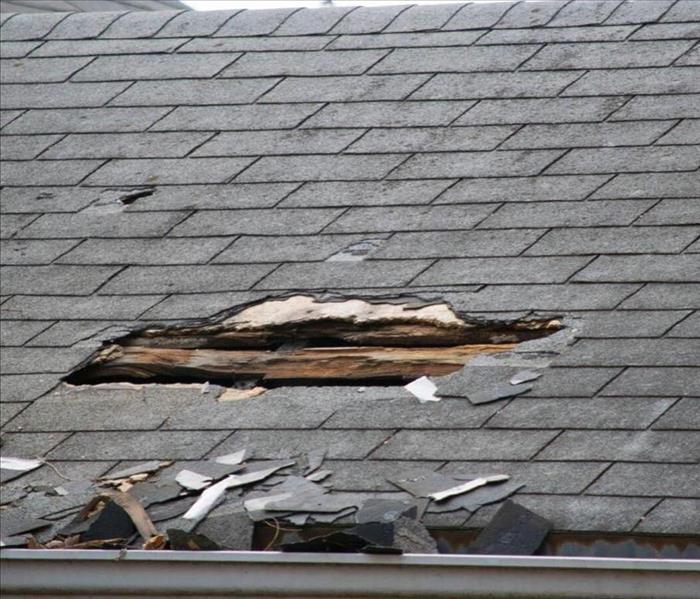 hole in the roof of a house from windstorm
hole in the roof of a house from windstorm
When a severe storm hits, your home or property can take quite the beating. And while most of the time your roofing and siding can handle it, there are occasions when the high winds and hail leave their mark. This is when it is crucial to be familiar with the most common signs of storm damage, so you know whether or not your home is ready to protect you and your family when the next storm hits. A storm doesn’t have to be a hurricane or tornado or cause detrimental damage to your home’s exterior. In fact, even a thunderstorm can damage your home if it brings strong winds, hailstones, or falling debris from nearby trees. Strong winds can do a lot of damage to your home. Wind can be strong enough to lift the edges of your roof and tear away shingles. It can also loosen or tear your shingles or even knock down your gutters. Wind can also pick up large debris like patio furniture and branches that get pummeled into your home’s siding, windows, and roof. This debris can cause extensive damage and require siding or roof replacement. If you have large trees that overhang your house, it might be a good idea to trim those branches back or get the tree assessed to prevent it from falling due to high winds. When a storm rolls through, you may notice your yard in disarray and worry that your home experienced more damage than to the landscaping. This is a definite possibility, especially if high winds or hail were involved. Unfortunately, some storm damage isn’t easy to spot with an untrained eye. But we’ll list out some of the signs that you sustained damage so you can take action right away. If you have an asphalt shingle roof and notice dark spots on your shingles that look like holes or dents, that could be granule loss. The small granules that cover your tar shingles can slough off from hail. These spots then become susceptible to leaks if left unrepaired. You can also look for granules in your gutters or downspouts, which means they broke off from hail and flowed down into the gutters. This is a good sign you need to get your roof inspected. Lastly, schedule a time to get your home repaired by SERVPRO. We’ve been in business for over 50 years and know how to handle just about any sort of damage that comes your way. We know what to look for, and our thorough inspections check your house from head to toe. We will document everything and give you an accurate estimate before we even begin working on your home. If you see any of these signs after a storm, don’t wait call SERVPRO and we will make it Like it never even happened.
What Happens Durning Storm Damage Restoration
7/11/2022 (Permalink)
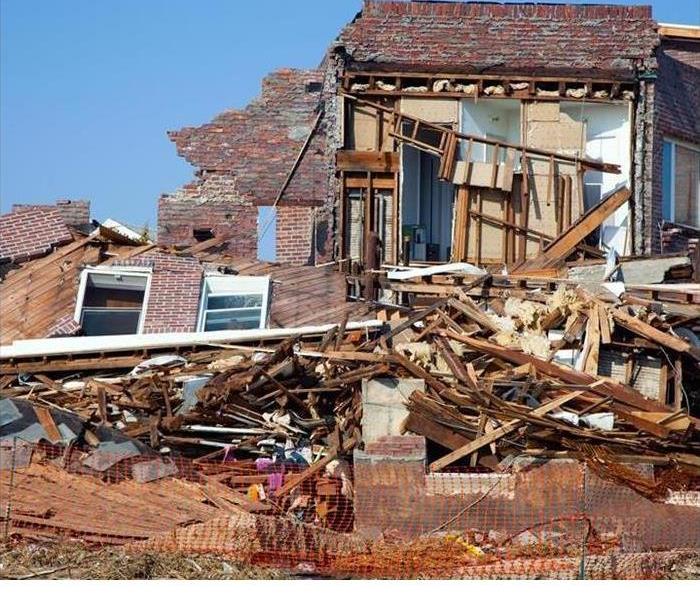 A storm came through and damaged the house. This is the property before restoration team came in
A storm came through and damaged the house. This is the property before restoration team came in
Severe storms can leave behind broken, disintegrated glass, roofs, ceilings, windows, along with other hazards. It is critical that the first priority following a hurricane is ensuring that everyone is safe. Generally, your first thought is to inspect the property to assess the storm’s damage. While this is important, there are more critical precautions you must conduct. Start by making sure that there’s no threat of electrocution. This is more likely if flooding has occurred, and down power lines are close to the property. If this is the case, stay away from the property until the power is cut. If your roof appears unstable, evacuate from the house until professionals can inspect the structure. Actively watch out for things such as nails, sharp debris, and glass. And most importantly, if the house smells of natural gas after the storm, notify the gas company immediately. Ensuring everyone’s safety will always be the number one step that is a non-negotiable act after a storm’s passing. After taking the necessary safety precautions, your second step is to guard and secure the property. Check for any broken windows, heavy leaks, and flooding. Board up any window that is still letting water in. Remove any valuable possessions that might be at risk. Remember, stagnant water is notorious for causing more severe problems. Also, water intrusion can lead to microbial growth which can be life-threatening. This step is overwhelming for most people. Reaching out to emergency restoration professionals is advisable.
Storm Damage and how we can help
7/4/2022 (Permalink)
 A tree has fallen on a house causing several different types of damage that SERVPRO can handle.
A tree has fallen on a house causing several different types of damage that SERVPRO can handle.
Tornadoes, hurricanes, ice dams, snowstorms… natural disasters can strike unexpectedly and they destroy anything in their path. We are always ready to help you when natural disasters occur. Our storm damage restoration specialists can expertly handle roof repair & replacement, siding damage, window board-up & replacement, interior cleanup and restoration, tree removal and a lot more.
We can handle any damage due to severe weather, including:
- Freezing weather and ice dams
- Hail and ice storms
- Hurricanes
- Lightning strikes
- Thunderstorms
- Tornadoes and high winds
Flash Flooding: What You Need To Know
6/14/2022 (Permalink)
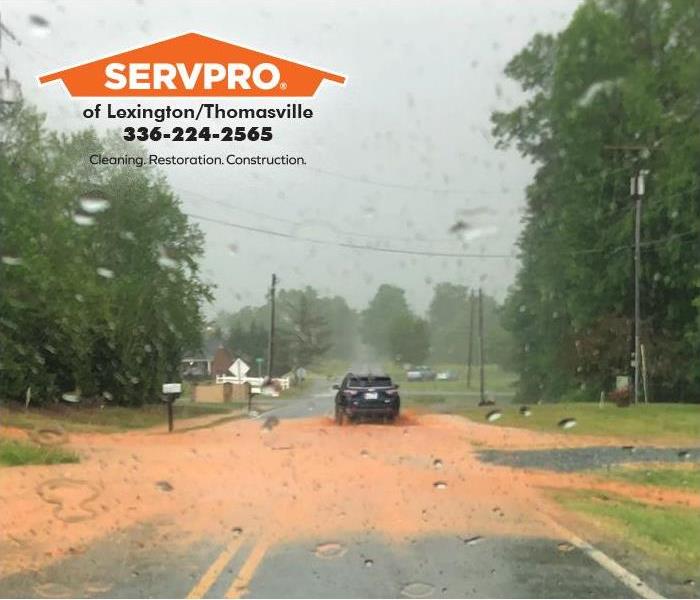 Flash flooding can happen within moments; stay alert.
Flash flooding can happen within moments; stay alert.
Summers in the south are known for a few things, including severe weather. One of the things we need to watch out for is flash flooding. According to weather.gov, flash floods are the #1 weather-related killer in the United States. Flash flooding happens when the intensity and duration of rainfall are too much for the soil or topography to handle. It can occur within minutes or hours after a rain event. Most flash flooding is caused by slow-moving thunderstorms or “training storms,” which are repeated areas of rain, typically associated with thunderstorms that move over the same region in a relatively short period of time.
Flood Alerts From The National Weather Service
- Flood Advisory means be aware.
- Flood Watch means be prepared as conditions are favorable to flooding.
*If these are upgraded to a warning, you must take action immediately. - Flash Flood Warning is even more imminent-this sudden violent flood can take just minutes to develop.
- Flash Flood Emergency is rarer. This is only used for the severe threat to human life or catastrophic flooding event.
Know your risks and have an emergency plan in place. And if your home or business is damaged due to flood waters, call the experts at SERVPRO of Lexington/Thomasville at (336) 224-2465. Our team of experts offers 24-hour emergency services and is here to help.
Did You Know?
5/21/2022 (Permalink)
According to the National Oceanic and Atmospheric Administration, flooding is becoming more frequent along the coastlines of the United States. Studying measurements from tide gauges at locations along U.S. coasts, the NOAA found that nearly every site measured has experienced an increase in coastal flooding since the 1950s. The mid-Atlantic region experienced the highest number of coastal flood days and also the largest increases in flooding from 1950 to 2015. Since 2010, no area has flooded more often than Wilmington, North Carolina, which flooded an average of 49 days per year. The United States Environmental Protection Agency notes that higher sea levels pose a number of threats to coastal communities, including making coastal infrastructure more vulnerable to damage from storms because that infrastructure was not designed to withstand frequent inundation or exposure to salt water. Coastal flooding, the EPA notes, also can affect human health by increasing the risk that drinking water and wastewater infrastructure will fail, potentially exposing people to pathogens and harmful chemicals.
Prepare Your Pets for Disasters
5/9/2022 (Permalink)
 By preparing you can ensure your pets are safe during a disaster.
By preparing you can ensure your pets are safe during a disaster.
Did you know that June is Pet Preparedness Month? And while you should be prepared year-round for your four-legged family members' needs, it's a great time to review your family's emergency plans to ensure you've included your pet.
Your pet is an essential member of your family, so they need to be included in your family's emergency plan. The following are the things you need to consider when creating an emergency plan for you and your pet:
- Make A Plan
- Build An Emergency Kit
- Stay Informed
Making A Plan
When preplanning for emergencies, you will likely have less difficulty and stress if an emergency occurs. When creating your evacuation plan, think of your pet.
- Does your pet travel well? If not, check with family and local shelters about boarding until the emergency has passed. If he does travel well, look at a couple of likely routes you would use to evacuate and get contact information for pet-friendly hotels.
- Is your pet microchipped? If not, do so immediately. This will help return your pet to you if he becomes lost. If your pet is microchipped, make sure your current and up-to-date contact information.
Build Your Pet's Emergency Kit
Like you and your family, your pet needs a supply kit just in emergencies. It may be beneficial to build two; a small lighter version if you have to evacuate and a larger, more detailed one for sheltering in place. Some things to keep in your kit:
- Food and water for several days. Include bowls and make sure your pet's food is in a waterproof, airtight container
- Medicines
- First Aid Kit Talk to your vet about what is appropriate to be in the kit
- Crate or Carrier
- Grooming Items Such as shampoo and brushes
- Sanitation needs such as litter and litter pan
- Favorite Items such as a favorite toy or blanket. This will help reduce your pet's stress and anxiety during such an uncertain time.
- A Photo of You And Your Pet. This will help document ownership if separated.
- Pet First Aid App on your mobile device. For more info, click here.
Stay Informed
You must keep up-to-date on current conditions. Purchase a NOAA weather radio with extra batteries. Also, download FEMA or local news apps to your smartphone. Finally, listen to local officials regarding evacuation or sheltering in place.
With preparation, you and your pet can handle anything mother nature throws at you. For a pet safety checklist, please click here.
When and Where Do Tornadoes Strike In North Carolina
4/25/2022 (Permalink)
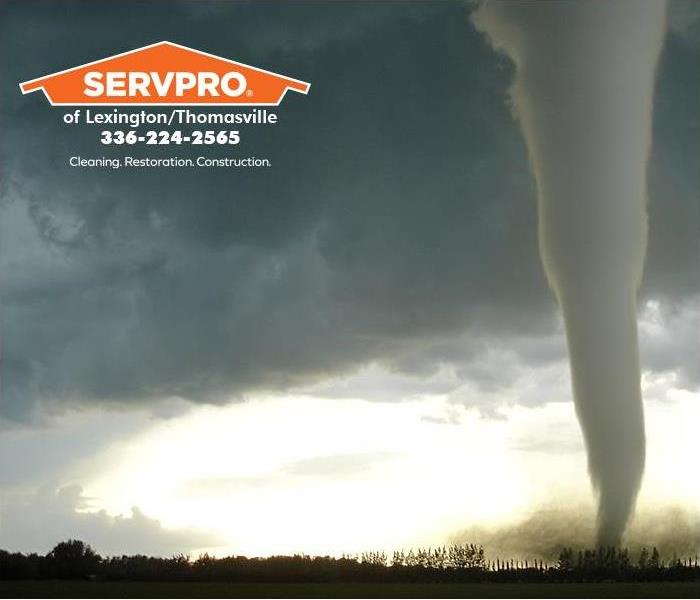 Tornadoes are nature's most violent storms. Spawned from powerful thunderstorms Tornado speeds can reach up to 300 miles per hour.
Tornadoes are nature's most violent storms. Spawned from powerful thunderstorms Tornado speeds can reach up to 300 miles per hour.
The state of North Carolina is no stranger to tornadoes and the damage that they cause. However, the frequency and intensity usually vary with most of the storms happening in the eastern part of the state. According to the North Carolina State Climate Office, from 1950-2019, North Carolina saw 1,387 tornadoes. That means North Carolina averages 29 tornadoes per year, with April and May's most active months.
What Should You Do?
To best be prepared for a tornado, your family should have a tornado plan in place, and you should practice it at least once a year. In addition, making sure your family knows where to shelter is critical in ensuring their safety. Also, make sure you have a Disaster Preparedness Kit available in your safe area.
If severe storms damage your home or business, contact the experts of SERVPRO of Lexington/Thomasville. Our team of highly trained professionals is available 24/7 for emergency services. Those services include:
- Roof Tarping
- Water Extraction Due To Flooding
- Board Ups
- More
Give us a call today at (336) 224-2565. At SERVPRO we’re here to help.
Preparing for Winter Weather
2/22/2022 (Permalink)
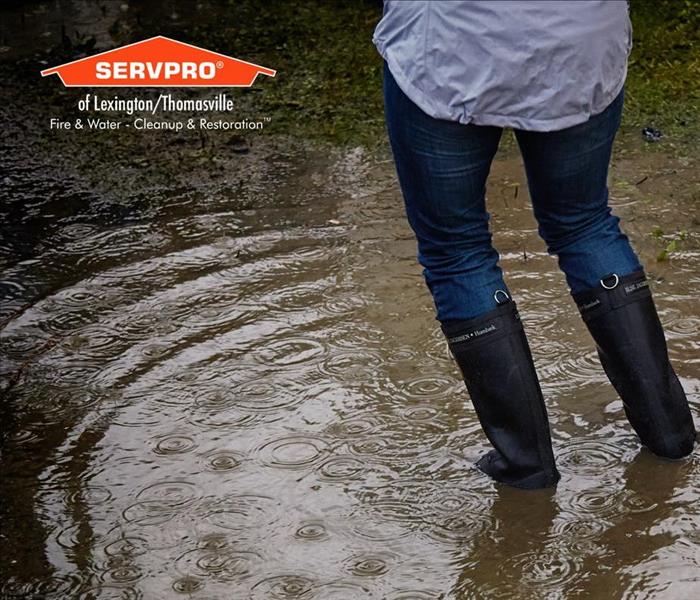 Storms can hit quickly and without warning. The experts at SERVPRO of Lexington / Thomasville can make your damage "Like it never even happened."
Storms can hit quickly and without warning. The experts at SERVPRO of Lexington / Thomasville can make your damage "Like it never even happened."
If living in North Carolina has taught us anything it’s taught us if you don’t like the weather wait 5 minutes. We can have 70° temperatures one day and snow showers the next. So, how to you prepare for unpredictable winter weather?
Some Simple Winter Tips To Help You Stay Prepared for Cold Weather
- Insulate water lines along exterior walls
- Repair small leaks quickly to prevent larger losses during cold weather
- Trim away tree branches that could fall on your house
- Dress in layers Typically during the late stages of winter we could have morning temperatures in the low 20° in the morning and in the mid 70° in the afternoon
- The most important thing you can do is to know who to call if you have storm damage.
At SERVPRO of Lexington / Thomasville our team of highly trained technicians can handle all types of storm damage. We can handle roof tarping from thunderstorms, to flooding basements to everything in between. At SERVPRO of Lexington / Thomasville we can make your storm damage “Like it never even happened.”® Give us a call today (336) 224-2565.
After The Storm: Know What To Look For In Your Winston Home
8/9/2021 (Permalink)
We hear almost daily about being prepared. Whether it’s something simple like preparing for the first day of school or something more serious like preparing your home for possible storms, having a checklist may help prevent you from becoming overwhelmed.
If you have structural damage from a storm, vacate the property immediately and contact your first responders, your insurance agent, and the SERVPRO of Lexington/Thomasville. While your agent starts the claims process, our team of highly trained technicians can begin securing your property once first responders deem it safe to enter. Our team will board up windows, tarp roofs and check for other visible damage. At the same time, first responders begin to assess any other emergency needs such as downed powerlines or other safety concerns.
Once the property is secure, you or the team of SERVPRO of Lexington/Thomasville can begin taking photos of the damage before anything is moved. Once all the damage has been documented, our technicians will begin to assess what can be saved.
We would begin inspection of your home, looking for cracks, leaks and other structural damage so a plan of action can be implemented. We highly recommend that you don’t try to do this yourself. If not correctly handled, storm-damaged can lead to further problems such as mold in your home. To learn more or schedule your free estimate, give us a call at 336-224-2565.
Flash Flood Warning: What Does That Mean For Your Clemmons Home Or Business?
7/23/2021 (Permalink)
Your phone or TV blares to life with an emergency alert: Flash Flood Warning In Your Location. What does that Mean? Do I need to worry since I am not near a river or stream? The truth of the matter is that you don’t need to live near a water source affected by flash flooding. Due to urban sprawl, flooding can happen anywhere. When you add the torrential downpours associated with flash flooding, anyone can experience flooding regardless of their proximity to a water source.
What Do I Do?
- If possible, make sure your gutters ad downspouts are debris free
- Immediately move to higher ground o rapidly rising water is seen or heard
- If outside, do no tempt to cross swiftly moving water
- Move essential documents/items to higher ground
- Bring outside furniture inside
If your home or business is affected by flooding, call the experts of SERVPRO of Lexington/Thomasville at (336) 224-2565. Our IICRC trained technicians are on call 34/7 to help protect your property and return it to preloss conditions. If you would like to learn more, give us a call today!
At SERVPRO we’re here to help.
Summer Storms Brings Rainbows and the Mold To Your Thomasville Home
7/12/2021 (Permalink)
Summer storms can bring about many things: green grass, lush trees, and even mold. It takes only about 36 hours for mold to colonize in your home. But why do we see an increase in the mold during the summer months? Summer in the south is known for two things: heat and humidity. In addition to the heavy rains typically seen during the summer, those things can increase the chance of mold in your home. A single mold spore in the right conditions could colonize and cause thousands of dollars if left undetected.
So, What Should You Do?
- To prevent water damage to your home, make sure you keep your gutters clean. Water from a stopped-up gutter can backflow into your home undetected until ugly yellow spots appear on your ceiling, and then it’s too late.
- Open the vents under your house to allow outside air to circulate to prevent moisture build-up.
- Make sure outside water drains away from your property.
- Keep a lookout for a musty smell.
If you suspect you have mold in your Thomasville home or business, give the experts at SERVPRO of Lexington/Thomasville a call at (336) 224-2565. We will come out to your property to determine if you have an issue with mold. If mold is present, we will walk you through the best course of action to get your property back to preloss conditions.
Because at SERVPRO, We’re Here To Help.
Step By Step Instructions For Restoring Your Lexington Home After A Storm
7/1/2021 (Permalink)
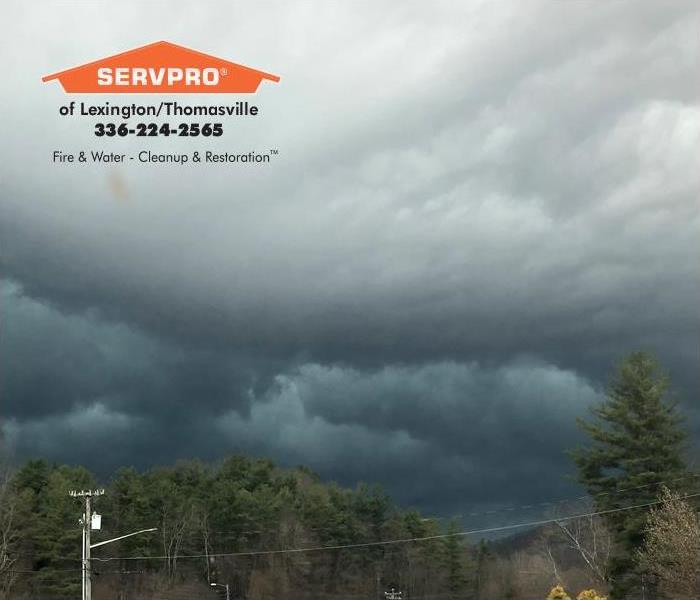 A severe storm rolls into town which has the potential to cause storm damage.
A severe storm rolls into town which has the potential to cause storm damage.
If the recent weeks have taught us anything recently, it’s taught us the weather is unpredictable. That unpredictability can lead to property damage.
Potential Damage From Area Storms
- Heavy rains cans can lead to flooding.
- High Winds can Bring Down Trees Or Cause Roof Damage.
- Tornadoes can cause widespread destruction.
So, What Do You Do If A Storm damages your Home
The first thing should be to contact your insurance provider to get the claim started. Then contact the experts of SERVPRO of Lexington/Thomasville at 336-224-2565. Our 24-hour emergency services are available to secure your property from additional damage and any security issues you may have.
The clean-up and restoration process should begin as soon as possible to prevent secondary damage. There is no need to wait for the adjuster to start the process. Our team will provide a photographic timeline and have notes documenting what was done to help prevent any questions the adjuster may have.
Once the property is secure, the drying and restoring process can begin. Our crew of highly trained technicians will walk you through each step, answer any questions, and address any concerns you may have. Our goal is to give exceptional customer service each and every time our phone rings.
When dealing with storm damage, call the professionals with over 50 years of experience: SERVPRO of Lexington / Thomasville at (336) 224-2465.
At SERVPRO we’re here to help.
2021 Hurricane Season Predicted to Be Active, Are You Prepared?
6/14/2021 (Permalink)
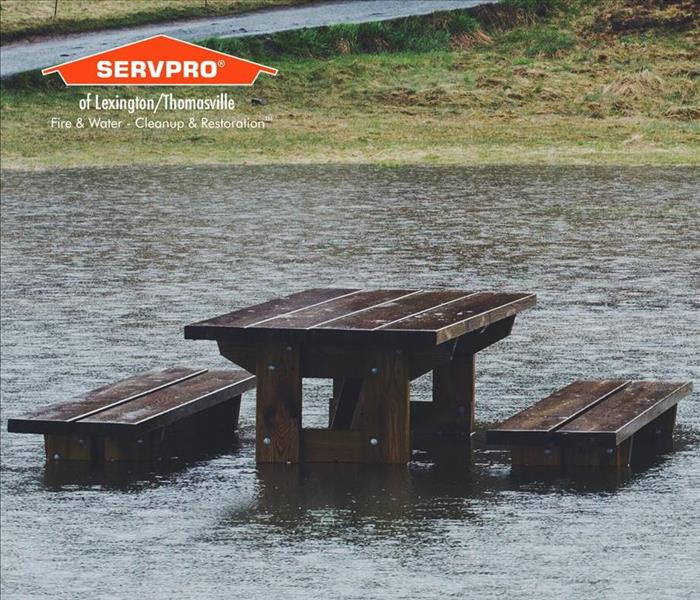 Flooding is the number one disaster in the U.S. and more than 20% of flood claims come from outside high-risk flood zones.
Flooding is the number one disaster in the U.S. and more than 20% of flood claims come from outside high-risk flood zones.
The North Carolina hurricane season runs from June 1 to November 30, but it generally peaks from mid-August to mid-October. But what does that mean for the Triad? Even if you don’t live on the coast, a hurricane can cause massive damage to inland North Carolina. They can bring flooding and destruction due to high winds and even tornadoes. So, how should you prepare? The good news is hurricanes are slow-moving and somewhat predictable, so you have days to prepare.
Build Your Emergency Supply Kit
- Water 1 gallon per person per day
- Fill the bathtub with water to be used for flushing the toilet
- Non-Perishable Foods
- Nonelectric Can opener
- First Aid Kit and Medicines
- Battery Flashlight and Weather Radio
- Food, Water, and Carrier for Your Pets
- Cell Phone And Charger
Additional Things To Have On Hand
- Insurance Agent Contact Information
- The local number for Gas Company
- The local number for Water Company
- The local number for Electric Company
For a more detailed list of preparations and supplies for severe weather in the Triad, visit ready.gov. And remember, just because we're not at the coast doesn’t mean we shouldn’t prepare. If you do experience storm damage, give us a call at (336) 224-2565
At SERVPRO, We’re Here To Help.
Protecting Your Welcome Home From Storm Damage
5/21/2021 (Permalink)
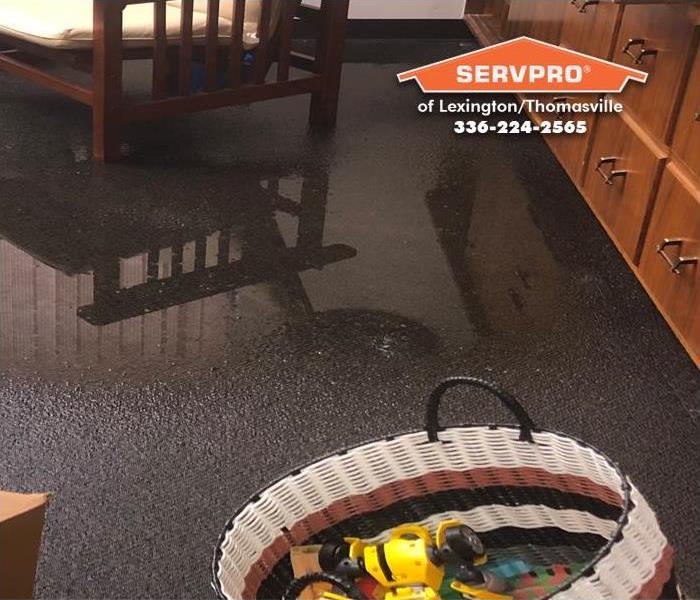 Storm damage can take many forms but if you call the experts at SERVPRO of Lexington/Thomasville we can make it "Like it never even happened."
Storm damage can take many forms but if you call the experts at SERVPRO of Lexington/Thomasville we can make it "Like it never even happened."
If living in the Piedmont has taught us anything, it’s that when summer rolls around, so do storms. Many people don’t realize that North Carolina has its own “Tornado Alley,” So with the threat of severe weather, what can you do to protect your home or business from damage due to storms?
- Check for dead Trees or Limbs. Dead, damaged or diseased trees may not be able to survive strong wind and hail. A fallen branch on your roof has the potential to cause thousands of dollars in water damage alone.
- Clean Out Your Gutters. Clogged gutters can cause water back up around your roof. During heavy rains, this backup can work itself under shingles and cause water spots on the ceiling and even mold damage. In addition, if the lower part of the gutter is not draining properly, it could cause foundation issues over time.
- Inspect Your Roof. Damaged or loose shingles will allow water into your home. Over time this will call soft spots in your roof and could be expensive to repair.
And if you experience storm damage to your Welcome home or business, give the experts at SERVPRO of Lexington/Thomasville a call at 336-224-2565. Our team of highly trained technicians is available 24/7/365 because we know no one plans on a disaster occurring, but with SERVPRO you can prepare if one does.
Why did My Insurance Carrier deny my Water Damage Claim?
5/10/2021 (Permalink)
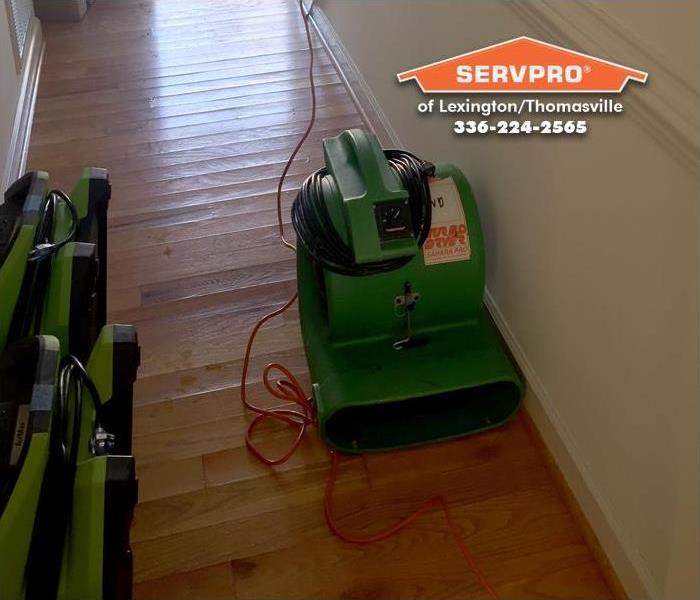 Water damage can cause thousands of dollars of damage if not addressed quickly.
Water damage can cause thousands of dollars of damage if not addressed quickly.
When you have insurance, many homeowners assume any and all claims they file will be covered. This includes any water damage caused by leaky pipes, storms, flooding, or sewer backups. But this is not the case. We highly recommend periodically checking in with your agent to review your policy to see exactly what is and is not covered. We thought we could explain some generalities when it comes to homeowner’s insurance.
A Typical Homeowner’s Policy Does Not Cover Flood Damage
Most homeowner’s policies exclude coverage for flooding. This would include microbursts, rising creeks, and rivers overflowing their banks and their runoff. Any easy way to remember the water damage caused by “outside water,” i.e., storms, flooding, hurricanes, etc. it will probably not be covered by your general home policy. If you would like to have coverage for those types of events, you need to talk to your agent about a separate flood policy.
Gradual/Long Terms Water Leaks Are Typically Not Covered.
Most homeowner’s policies cover sudden water losses due to a burst pipe inside the home, sudden toilet leak, or leaking appliance. However, if this leak is gradual and you do not notice it right away, the claim could be denied. If the insurance adjuster feels the leak is more than 14 days, the claim could be denied and classified as a loss due to a maintenance issue.
Handling A Water Claim
And while these are just general guidelines knowing who to call if a water loss does occur is critical because even the most conscientious homeowner can sometimes experience water damage in their home.
SERVPRO is a trusted name in the industry and works closely with hundreds of insurance carriers.
If you experience a water loss in your home or business, call SERVPRO of Lexington/Thomasville. Our highly trained technicians are certified by the IICRC as experts in water mitigation and restoration. Ad with our 24-hour emergency services, we’re here when you need us. To learn more give us a call today at (336) 224-2565.
At SERVPRO, we’re here to help.
Severe Weather: Know Your Risks
4/8/2021 (Permalink)
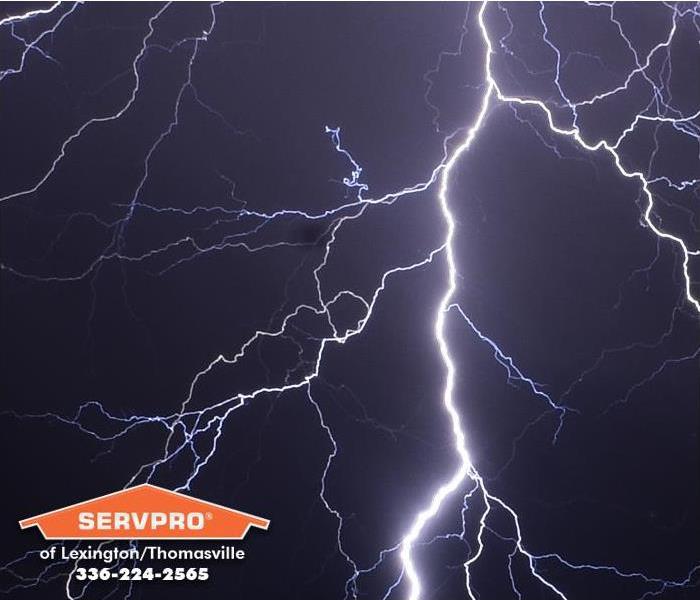 Severe weather can strike anytime. If it does, call the experts of SERVPRO of Lexington/Thomasville today.
Severe weather can strike anytime. If it does, call the experts of SERVPRO of Lexington/Thomasville today.
The weather is turning warmer, and that a whole new set of weather concerns will arise. From tornadoes to lightning, flooding, to thunderstorms, spring weather is unpredictable and could be dangerous.
Understand Severe Weather Risk Levels
- Level O: General Thunderstorms: This is a very common threat level. It means the storms should not be life-threatening or cause damage.
- Level 1: Marginal Risk: This is a common level. It means a few storms could rise to close to a severe level.
- Level 2: Slight Risk of Severe Weather: This is a somewhat common occurrence in this area. This means scattered severe weather is possible. Storms could cause significant or life-threatening damage but is unlikely.
- Level 3 Enhanced Risk: This is a somewhat common threat level in this area. Numerous severe storms are possible, and these storms may cause significant damage and be life-threatening. A few tornadoes are possible.
- Level 4: Moderate Risk: This is an uncommon threat level for this area. A moderate risk means numerous severe storms are likely. Significant damage or life-threatening storms are possible. It also means several tornadoes are possible with large hail and wind damage.
- Level 5: High-Risk Level: This is a rare threat for this area. This means significant damage and life-threatening storms are likely. A tornado outbreak with a line of intense, widespread wind damage is also likely.
Being prepared is critical to ensure the safety of your family. The National Weather Service recommends a battery-operated weather radio tuned to your area or some type of weather alert system to keep you informed if severe weather is expected.
If severe weather damages your home or business, give the professionals of SERVPRO of Lexington/Thomasville a call at (336) 224-2565.
With our 24-hour emergency services, we can tarp roofs, board up windows to help secure your property and prevent secondary damage. Because at SERVPRO, we’re here to help.
Winter Checklist for Your Thomasville Home Or Business
2/22/2021 (Permalink)
Winter causes its own list of problems and concerns with it comes to your property. Freezing rain and snow can cause limbs to break and damage your roof. Heavy rain can cause flooding. Clogged or dirty gutters can cause foundation issues and water damage to your property.
So what can you do to prevent damage?
- Check your heating system. Preventative maintenance and cleaning of your heating system can help prevent puff backs.
- Clean your chimney. A chimney fire can cause severe damage to your home.
- Paint caulk and seal exterior wood to prevent rot.
- Drain outside faucets and remove hoses to help prevent pipes from freezing.
- Check the insulation around your pipes.
By doing a little preventative maintenance now, you could save yourself thousands of dollars in repair bills.
And if the unimaginable does happen, call the experts at SERVPRO of Lexington/Thomasville at 336-224-2565. Our team of professionals offers 24-hour emergency services to help prevent secondary damages and get your home or business back to preloss conditions as quickly as possible. TO learn more, give us a call or visit our website at www.SERVPROlexingtonthomasville.com. Because at SERVPRO, we’re here to help.
Why hire SERVPRO of Lexington/Thomasville
12/16/2020 (Permalink)
No home is impervious to damage — whether from natural weather phenomena or incidents that occur as byproducts of daily life. Floods, fires, tornadoes, and other events can cause immediate damage to a home, though some damage occurs more gradually.
Repairing a home becomes a priority after a disaster when authorities have deemed it safe to reenter the property. The extent of disaster-related damage is often beyond the scope of a homeowner’s abilities. In such instances, a disaster remediation firm such as SERVPRO of Lexington/Thomasville can protect homeowners from additional dangers and may help them save money in the long run. Here’s a look at the type of benefits we can provide.
- Find hidden damage: SERVPRO knows how to uncover issues such as weakened structures, smoke damage and water damage that is not visible to the naked eye. Hidden dangers can include hazardous materials produced by the disaster or damage that can adversely affect residents’ health.
- Address mold growth: Flooding, a leaking pipe or hose water used to extinguish a fire can leave behind conditions that are ripe for mold growth. Mold growth can occur in as little as 48 hours after damage occurs. SERVPRO of Lexington/Thomasville has the equipment to dry out and clean building materials in the home to reduce or eliminate the risks of mold growth.
- Employ the latest technology: The wrong tools can not only slow down progress, they can make work less safe. SERVPRO uses the latest equipment when restoring properties. Certain equipment is tailor-made to address issues that often arise after natural or manmade disasters. Such equipment may prove too costly for DIYers, but its use can make the difference between a quick cleanup and a lengthy project.
- Necessary training: SERVPRO requires its staff to stay up-to-date with the latest techniques. All of our employees are required to participate in continuing education. This can help reduce the likelihood of accident or injury during the restoration process and ensure we provide the best customer service possible.
This is just a few of the benefits from hiring SERVPRO of Lexington/Thomasville to clean up your property after it has been damaged. If you would like to schedule your free estimate, give us a call at (336) 224-2565 today.
The threat posed by ice dams
11/23/2020 (Permalink)
Cold, snowy weather can present various issues for homeowners to contend with. One such problem, ice dams, can cause damage to walls, ceilings and other areas. The University of Minnesota Extension says that an ice dam is a ridge of ice that forms at the edge of the roof and prevents melting snow from draining properly. A complex combination of heat loss from a home, snow cover and outside temperatures can lead to the formation of ice dams. An ice dam will be fed by melting snow above it and cause a backup at the edge of the roof. Dams can cause gutters to tear off and loosen shingles and may lead to water backing up and pouring into the home, advises This Old House. Ice dams also can contribute to soggy insulation, making the insulation lose its protective R-value and becoming a magnet for mold and mildew. Homeowners can do a number of things to temporarily prevent the formation of ice dams. Heated cables clipped to the roof’s edge in a zigzag pattern can help prevent dams that lift shingles. Pushing snow off the roof can help. Laying an ice melt product in gutters to help melt the ice that forms also can prevent ice dams. More permanent solutions involve keeping the entire roof the same temperature as the eaves by increasing ventilation, adding insulation and properly sealing air leaks that can warm the underside of the roof. This may involve calling in a professional contractor. Such an investment is well worth it, as it can prevent much more costly damage down the line.
If you experience water damage from an ice dam or frozen pipes, give the experts of SERVPRO of Lexington/Thomasville a call at 336-224-2565.
The Proper Way to Winterize Your Clemmons Home
11/15/2020 (Permalink)
As 2020 draws to a close and colder weather approaches, now is the time to winterize your home. Freezing temperatures and winter weather can cause thousands of dollars in damage if your home is not winter ready. This simple checklist highlights some of the most frequent problems we see.
Checklist for Winterizing Your Home
- Check your gutters. If your gutters are filled with debris, it could cause ice and moisture to back up in your home and damage your roof.
- Disconnect all outside hoses. If you leave the hose attached, your outside faucet water can remain in the pipe, which could freeze.
- Weatherproof Windows and Doors. By installing weatherstripping around your windows and doors, you can prevent cold air from entering your home and hopefully preventing your pipes from freezing.
- Check your Furnace. Your Furnace works hard during the winter. The last thing you need is for it stops working. By merely changing your Furnace’s filter, it will help it run more efficiently and hopefully preventing additional furnace problems.
- Remove Overhanging Tree Branches. These tree branches can be weighed down by snow and ice and fall on your property or home.
By following these steps and others, you can protect your home this winter. And, if the worst should happen, give the experts of SERVPRO of Lexington /Thomasville a call at (336) 224-2565. With our 24-Hour Emergency Services, we can make natural and manmade disaster "Like it never even happened."®
How to plan for changing weather
8/10/2020 (Permalink)
The allure of the great outdoors compels many people to hike, kayak, fish, and engage in myriad other activities in the fresh air. The call of nature can be difficult to ignore, but inclement weather can quickly turn a fun day under the sun into a race to escape the elements. Regardless of which activity is beckoning you to answer the call of the wild, a few simple safety measures should be taken to ensure your day is not derailed by sudden changes in the weather.
- Do your homework prior to traveling. The Department of Homeland Security advises travelers and outdoor recreation enthusiasts to learn about potentially severe weather in areas they plan to visit prior to beginning their trip. For example, if an area is vulnerable to tornadoes, learn about what to do in the wake of a tornado. The National Weather Service notes that emergency response protocols differ depending on the type of storm or severe weather. For example, what to do in the wake of a tornado differs from what to do when confronted by a flash flood. Familiarizing yourself with these response protocols can help you make it through unforeseen weather changes safely.
- Take along an extra set of keys. The NWS advises taking along an extra set of keys should your keys get lost due to inclement weather. The spare keys to a vehicle, for example, can help you escape inclement weather if your vehicle is still accessible and the roads are safe enough for travel. Without a backup set of keys, outdoor enthusiasts may find themselves stranded even if their vehicles can still run.
- Create a communication plan with your family prior to leaving. A predetermined communication plan can help family members keep in touch should the weather suddenly take a turn for the worse. Before embarking on a getaway, let loved ones who won’t be joining you know exactly where you will be staying and how to reach you. This can make it easier for them to get you help should you need it.
- Monitor local forecasts. Changes in the weather can be sudden, so anyone planning to spend significant time outdoors should monitor local forecasts before and during their trips. This is especially important for travelers who will be visiting areas during certain times of year when inclement weather is normal. For example, travelers should be ready to postpone their plans if they will be visiting areas vulnerable to hurricanes during hurricane season.
- Purchase travel insurance. Insuring a trip with travel insurance can serve as a financial safety net if a trip is not possible due to inclement weather. With such a policy in hand, vacationers may not feel compelled to travel if the forecast is less than ideal.
Inclement weather can threaten outdoor excursions. But outdoor enthusiasts can take various measures to protect themselves in the face of sudden or unforeseen changes in the weather.
Storm Safety
7/24/2020 (Permalink)
Fireworks are not the only thing that light up the sky on warm evenings. Hot, humid weather often presents the ideal conditions for the formation of thunderstorms to form.
The National Severe Storms Laboratory estimates that 16 million thunderstorms occur across the globe each year. The NSSL says that, at any given moment, there are 2,000 thunderstorms in progress. In the United States, eight cities in Florida top the Farmer’s Almanac list for the most thunderstorm-prone areas. The regions’ average conditions can be highly favorable for producing thunderstorms.
Although thunderstorms can be exciting to watch from the safety of indoors, these storms can be strong and dangerous. Thunderstorms are often accompanied by damaging winds and large hail. Thunderstorms can move in very quickly and produce flash flooding conditions. The American Red Cross offers that every thunderstorm produces lightning, which kills more people each year than tornadoes or hurricanes.
Despite advance warnings, people are killed or seriously injured by severe thunderstorms each year. Respecting the power of a thunderstorm can help keep people safe.
- Follow the 30/30 lightning safety rule. When lightning flashes, immediately go indoors if you cannot count to 30 before hearing a thunder-clap. Remain indoors for 30 minutes after hearing the last rumble of thunder.
- Upon hearing thunder, get out of boats, pools and other bodies of water.
- Unplug electronic equipment that may be susceptible to damage from power surges caused by lightning hitting power lines.
- Be sure to have a flashlight and extra batteries handy in the event of a power outage.
- Listen to the local news or NOAA Weather Radio for emergency updates.
- Get to higher ground if flash flooding is possible.
- Avoid contact with plumbing fixtures, as water conducts electricity.
- Do not try to drive during severe thunderstorms. Afterward, do not drive through standing puddles. They may be too deep to gauge.
- Stay away from windows.
- If you are caught outdoors, seek shelter if possible. If shelter is not available, find a low area away from metal areas or tall objects that can attract lightning. Curl into a ball and make yourself as small as possible.
- After the storm, stay away from downed power lines and report them immediately.
Did You Know?
7/13/2020 (Permalink)
 The Federal Emergency Management Agency, or FEMA, notes that it’s important for parents of school-aged youngsters to familiarize themselves with the e
The Federal Emergency Management Agency, or FEMA, notes that it’s important for parents of school-aged youngsters to familiarize themselves with the e
The Federal Emergency Management Agency, or FEMA, notes that it’s important for parents of school-aged youngsters to familiarize themselves with the emergency response plans established by their children’s schools. Such plans typically include how the school will respond if school is in session during snowstorms or natural disasters, as well as the protocol surrounding lockdown situations where children may be in danger. In such situations, knowledgeable parents who are familiar with emergency response plans and how to communicate with school officials and how those officials will disseminate information to concerned parents can help first responders and educators focus on their responses, which may involve protecting children. Knowledge of these plans also can calm parents’ nerves and reduce the likelihood that school campuses will become chaotic in the wake of potentially dangerous situations, including storms or natural disasters. In addition to learning about schools’ emergency response plans, parents can discuss these plans with their children. Such discussions should emphasize the importance of following educators’ instructions during both practice drills and when the plans are implemented in response to disasters or other threats.
To learn more about these plans you can contact your child’s school or visit their website. To learn more about Davidson County’s Plans please click https://bit.ly/38gVpC8.
It is also important to create an emergency response plan for your home. At SERVPRO of Lexington/Thomasville we offer homeowners a no cost mobile app to assist in creating an emergency response plan. Our ERP is free to any homeowner or business who needs help creating an emergency response plan. To learn more about our ERP app simply give us a call at 336-224-2565 or visit. https://ready.SERVPRO.com.
In case of emergency, find the safest room in your Welcome home
7/5/2020 (Permalink)
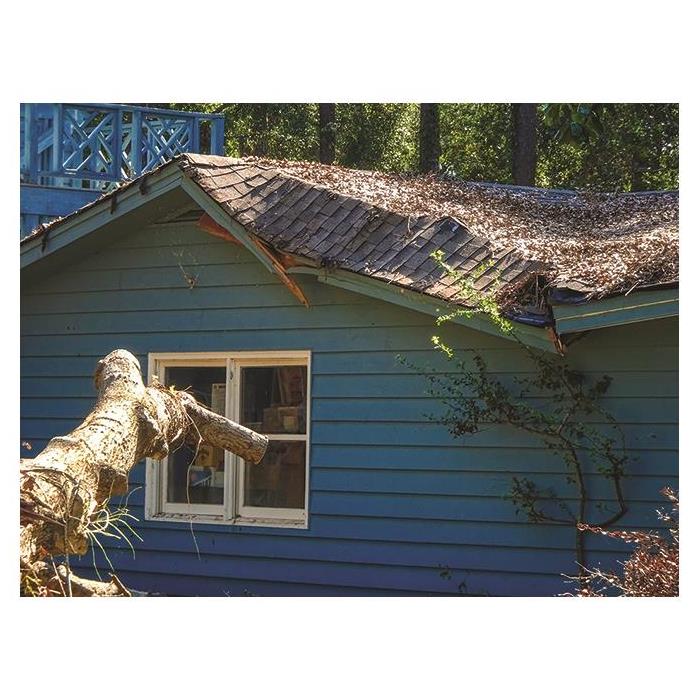 This home's roof was damaged from a falling tree during a violent storm.
This home's roof was damaged from a falling tree during a violent storm.
In the event of an emergency, particularly weather-related disasters with high winds like hurricanes or tornadoes, safety officials urge homeowners to take shelter in the safest room in their homes. Determining where this might be depends on the structure itself. Generally speaking, look for an interior room that is near the center of the house. It’s often best to choose one that doesn’t have windows or with windows that are very small. Bathrooms or walk-in closets are typically the safest areas in one-story homes. In two-story homes, the strongest wall of the house is often near the stairwell. Therefore, a first-floor closet may be the best spot. The National Weather Service says that in the event of a tornado, being underground is best, so seek shelter in a storm cellar or basement. However, if no subterranean shelter is available, seek out shelter as far inside the structure as possible, ideally in a small space. Again, bathrooms, closets, under stairs, or in a hallway may be the best bets.
And if the unimaginable happens, we at SERVPRO offer 24-hour catastrophic storm response which includes board ups and roof tarping. If you would like to learn more give SERVPRO of Lexington/Thomasville a call at 336-224-2565.
Tornado Safety Guide
6/15/2020 (Permalink)
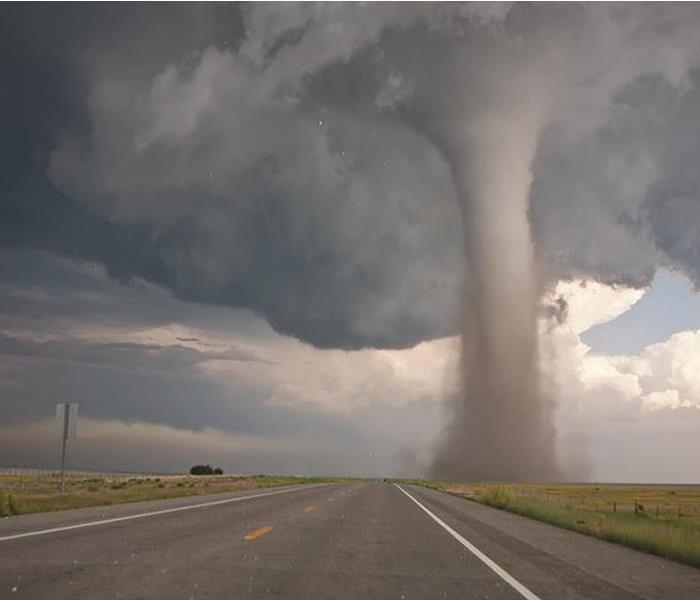 The Department of Homeland Security notes that there are many things people can do to keep themselves safe from tornadoes before, during and after the
The Department of Homeland Security notes that there are many things people can do to keep themselves safe from tornadoes before, during and after the
Roughly 1,000 tornadoes per year are reported to the National Oceanic and Atmospheric Administration. Tornadoes are intense, violent storms that feature a column of air that extends from a thunderstorm cloud to the ground. Tornadoes can occur anywhere in the world. However, the United States experiences more tornadoes than any other country. According to Verisk’s Property Claim Service, tornadoes accounted for 39.9 percent of insured catastrophe losses from 1997 to 2016, and the average annual loss on these severe storms was $11.23 billion. Tornadoes, although impressive to watch, are volatile storms with great power. They have the capability to flip cars, destroy buildings and send deadly debris flying into the air. Intense winds can reach more than 200 miles per hour.
The Department of Homeland Security notes that there are many things people can do to keep themselves safe from tornadoes before, during and after these storms.
Before
Understand and learn about the risk for tornadoes where you live. People in the midwestern and southwestern United States have a greater risk of experiencing tornadoes than those elsewhere in the country. Establish a safe room in your home, which can be a basement or a cellar. In rooms with no below-ground levels, the safest place is a small, interior room on the lowest level away from windows and doors. Sign up for emergency alert warning systems that cater to your area so you know well in advance if a tornado is coming. Practice what to do in the event of a tornado so the entire family knows what to do if disaster strikes. Keep tornado readiness supplies handy. These include clean water, batteries, flashlights, a battery-powered radio, and packaged, nonperishable foods.
During
Move indoors into a safe location for the duration of the tornado. Tornadoes blow through quite quickly so timing is of the essence. If you cannot get to shelter, lay down flat in a low-lying area. Do not go under a highway overpass or attempt to outrun a tornado in a vehicle. Take additional precautions by shielding your head and neck with your arms or putting furniture and blankets around you to protect against debris. Keep small children and pets close by and protect them as best as possible. Strapping an infant into a vehicle safety seat may be a good safety measure.
After
Assess the situation for safety after the tornado has moved through. Watch for downed electrical lines and check for the smell of gas. Do not turn on any appliances or switches if you detect the aroma of gas. Do not try to move anyone who seems seriously injured unless they are in immediate danger. Call and wait for help if needed. It may take time for emergency personnel to reach you.
SERVPRO of Lexington/Thomasville offers stream response. From roof tarpping, to more serious damage we are available to help 24/7. Give us a call at 336-224-2565 to learn more about our services. For more information on Tornadoes is available at www.ready.gov/tornadoes.
When Heavy Rains Damage Your Lexington Business
5/26/2020 (Permalink)
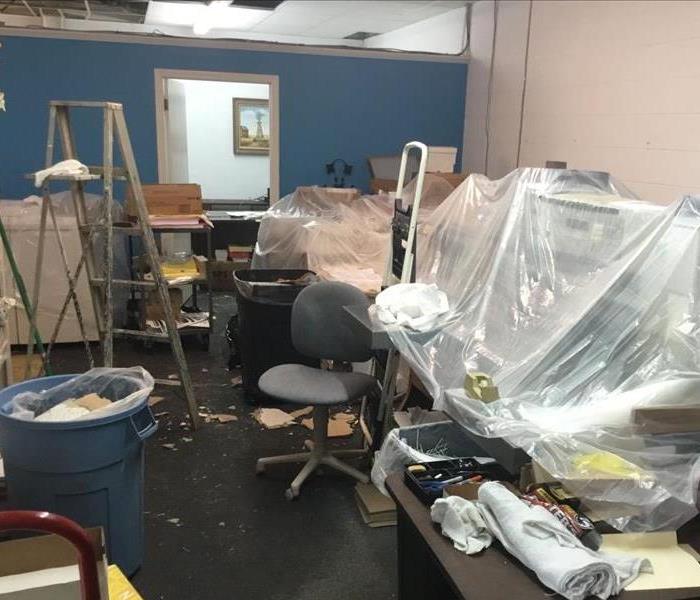 The roof of this Lexington business came off during spring storms causing extensive water damage in all their offices.
The roof of this Lexington business came off during spring storms causing extensive water damage in all their offices.
With several inches of rain forecasted for the Triad over the next several days, many businesses may experience water damage due to storms or flash flooding. Knowing who to call when your Lexington business experiences water damage knowing who to call is critical to preventing extensive downtime. If you call the experts at SERVPRO® of Lexington / Thomasville, you will have over 50 years of experience available to make your storm damage “Like it never even happened.”
Our catastrophic storm response team will arrive onsite anytime day or night to begin the restoration process. Emergency services include roof tarping, flood damage response, and contents restoration. We will create an individual plan of action to mitigate and restore your business to preloss conditions.
If you would like to know more about our storm response services or would like to schedule an appointment to come out and look at your storm damage, give us a call at 336-224-2565. At SERVPRO® of Lexington / Thomasville, we’re here to help.
Don’t be shocked! Separate lightning facts from fiction.
5/11/2020 (Permalink)
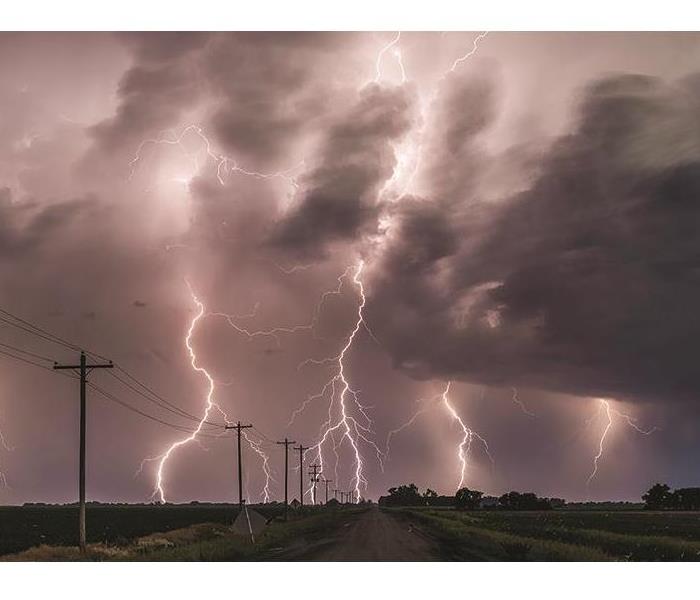 As afternoon summer storms return, it can help to dispel some of the myths about the energy and science behind lightning storms.
As afternoon summer storms return, it can help to dispel some of the myths about the energy and science behind lightning storms.
Lightning is an awe-inspiring display of nature. Captivating, careening streaks of light brighten the sky and are often accompanied by Earth-shaking booms of thunder. Is it any wonder that people are equal parts fascinated and terrified of lightning? That’s likely due to the immense power contained in lightning storms. Every bolt of lightning delivers up to one billion volts of electricity, states National Geographic. As afternoon summer storms return, it can help to dispel some of the myths about the energy and science behind lightning storms.
MYTH: Lightning doesn’t strike the same place twice. FACT: Contrary to what the familiar expression may indicate, lightning can and frequently will strike the same place twice, offers Britannica. It may occur during the same storm or years or centuries later. There’s no guarantee that a spot already hit by lightning is now immune.
MYTH: Crouch down to avoid a lightning strike outside. FACT: The National Weather Service says that crouching closer to the ground will not make a person any safer outdoors. Moving indoors to a substantial building or a hard-topped vehicle is better.
MYTH: Rubber tires insulate a car from lightning strikes. TRUTH: It’s actually the metal roof and metal sides of the vehicle that channel the lightning down to the ground, helping to safeguard people inside the vehicle. Remember, convertibles, fiberglass RVs and motorcycles are on rubber tires and offer no protection against lightning.
Recognize flood-related hazards
4/10/2020 (Permalink)
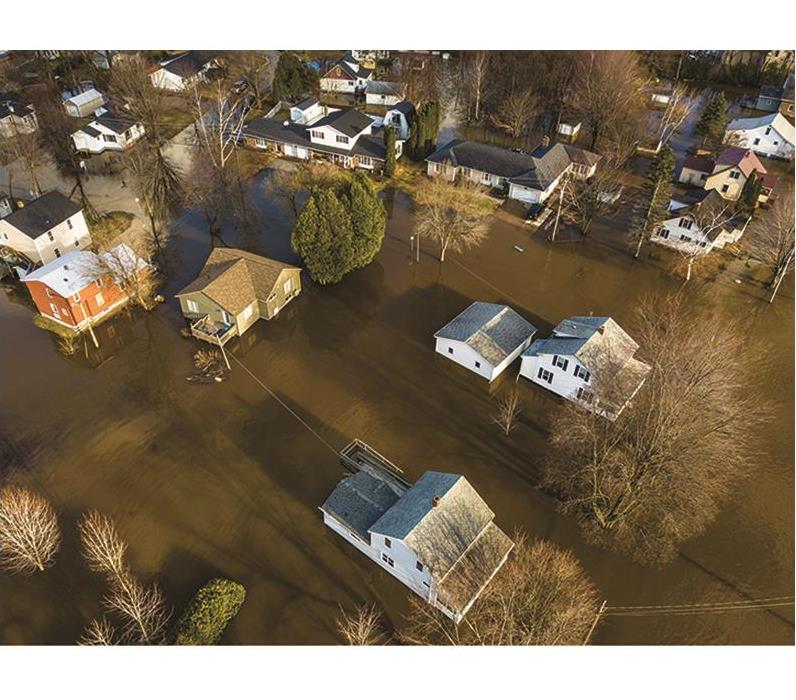 The Federal Emergency Management Agency warns that every community and person should be aware of the dangers of flooding and prepared to take action.
The Federal Emergency Management Agency warns that every community and person should be aware of the dangers of flooding and prepared to take action.
Few weather events are as impactful and widespread as flooding. Floods can happen anywhere, and because of their ferocity, they are not a force to take lightly. The National Weather Service says flooding typically occurs when prolonged rain falls over several days, or when heavy rain falls or snow melts in a very short period of time. In such instances, the soil cannot absorb water runoff fast enough to avoid flooding. Flooding also may occur due to the failure of a water control structure, such as a dam or levee. Storm surges from tropical and non-tropical storm systems are other leading causes of flooding, particularly in coastal areas. The U.S. Geological Survey says floods create billions of dollars in damage and have been known to kill hundreds of people each year. Some ways floods can wreak havoc include loss of housing, crop failure, damage to roadways and infrastructure, and contamination of drinking water. The Federal Emergency Management Agency warns that every community and person should be aware of the dangers of flooding and prepared to take action.
• Listen to radio and television reports about flooding and get to higher ground if you are in a low-lying area.
• Know your risk for flooding, assemble an emergency kit and have a plan for escaping or riding out flooding in your home. All household residents should learn and practice this plan.
• Flood water can damage electrical power, natural gas and propane gas systems. The Centers for Disease Control and Prevention says to minimize fire hazards by turning off these utilities during or after a flood. But only do so if you can do this from a dry location.
• Always obey evacuation orders immediately.
• NOAA says a mere six inches of water can knock you off your feet. Try not to venture into flood waters on foot or by car. It only takes seconds to get swept away and potentially drown.
• Flood water can be mixed with sewage and other hazardous substances, warns AccuWeather. It also could be hiding downed power lines or sharp objects. Avoid contact with flood water, as it may pose a risk for intestinal diseases or infections in open wounds.
• All dampened structures will need to be properly dried out, which often necessitates utilizing a professional service. Otherwise mold and mildew can fester and lead to serious structural issues, not to mention sickness.
• Use protective clothing and a mask when cleaning up after a flood to avoid respiratory problems.
• Never enter a flood-damaged home or building until it has been declared safe by authorities.
• If you are concerned about flooding, speak with an insurance representative about flood insurance. Flood losses typically aren’t covered under a homeowner’s or renter’s insurance policy. Damage can cause a catastrophic financial loss otherwise. Floods are intense and scary events that require extreme caution and care before, during and after the event.
Severe Weather Preparedness Week
2/24/2020 (Permalink)
According to the National Weather Service, North Carolina’s Severe Weather Preparedness Week is March 1-7, 2020. It is the time to increase your awareness of the type of severe weather protentional in your area as well as prepare for these events. The most common type of spring severe weather in our area is tornadoes. The peak month for Tornadoes to hit our regions in April. To help better prepare for spring severe weather season The American Red Cross has a list of safety tips:
Know the difference between a watch and a warning. A watch means severe weather is possible. A warning means severe weather is happening now or will be very soon.- Identify a safe place in your home or business is severe weather occurs. If a basement is not available, the centermost room without windows is advisable.
- Have an emergency radio available
If outside and no structure is present lay in a ditch or the lowest space available while covering your head. - If stuck inside a vehicle, stay inside leave the engine running and windows up. Cover your head with your hands while staying below the windows.
- Have an emergency plan for your home and business.
SERVPRO of Lexington/Thomasville offers a free Emergency Response Plan designed to help you recover quicker after a natural or manmade disaster. The ERP securely stores important information such as insurance policy numbers, emergency contacts, and more.
If the worse should happen and severe weather does strike our region SERVPRO of Lexington/Thomasville offers 24-hour emergency catastrophic storm response. We are always here to help so, give us a call at 336-224-2565 to learn more.
Stock the car for roadside emergencies
1/20/2020 (Permalink)
Disasters can happen in a flash, and having a plan in place for common emergency situations can make it easier to handle adverse conditions, particularly when away from home. According to MFASCO Health and Safety, a supplier of first aid supplies and kits, 90 percent of people do not carry first aid supplies or other emergency gear in their vehicles. Among those who may carry supplies, 30 percent never check to determine if they’re in good working order. The National Safety Council says that drivers should always keep emergency supply kits in the trunks or cargo areas of their vehicles. Kits should be inspected every six months, and worn out items should be replaced. Roadside emergency kits can make the difference between getting back on the road safely or being stranded for hours. Such kits also may help prevent or treat injuries, potentially saving lives. Weather should be considered when preparing vehicle emergency kits, which should include the following.
• A properly inflated spare tire and tire-changing equipment
• Jumper cables
• A multipurpose utility tool and/or tool kit
• Flashlight and batteries
• Flares or triangle reflectors
• An extra quart of motor oil
• A first-aid kit containing at the least, gauze, tape, bandages, antibiotic ointment, aspirin, nonlatex gloves, scissors, hydrocortisone, thermometer, tweezers, and instant cold compress
• A blanket
• A tire pressure gauge
• A portable tire inflator
• Paper towels
• Nonperishable, high-energy foods
• Drinking water
• A reflective vest
• Duct tape
• A fire extinguisher
• An ice scraper
• A folding shovel
• Coolant and washer fluid
• A phone charger
• Baby/child supplies, if pertinent
• Rope
Keep roadside emergency kits organized at all times. Store items securely in a milk crate, box or backpack so they are always readily available. People should familiarize themselves with the items in the kit so they know how to use them correctly and quickly. With some planning and organization, drivers can have the supplies they will need to make it through roadside emergencies safely.
Winter Storm Safety for your Thomasville Home
12/11/2019 (Permalink)
 As little as a quarter inch of rain can cause trees to break and power lines to snap.
As little as a quarter inch of rain can cause trees to break and power lines to snap.
Living in the Triad of North Carolina has many benefits. One of which is our beautiful weather. But with our unique location between the mountains and the coast, residents not only have to prepare for hurricanes and tornadoes but severe winter weather.
Winter Storm Warnings should be taken as seriously as any other type of weather warning, and residents should take immediate precautions when the notification is announced. We are in a unique location in our state. A few miles in either direction and the winter weather can be literally anything from a dusting of snow to several feet or even deadly freezing rain. A mere quarter of an inch of freezing rain can cause massive amounts of damage to trees and powerlines, thus putting your home or business at risk.
So, how should you prepare for winter weather?
Before the Storm
- Remove all low hanging limbs from around your home or business.
- Assemble an Emergency Preparedness Kit
Create a plan of action in the invent you lose power - Make sure all winter maintenance is done on your vehicle and it has a full tank of gas
- Stock up on food for you and your pet
- Double-check to make sure your pipes are well insulated
- Stock up on fuel oil or wood for your fireplace if needed
During the Storm
- Have a weather radio handy or download a weather app to your phone
- Bring your pets indoors
- Stay indoors
After The Storm
- Avoid overexertion. Heart attacks from shoveling heavy snow are a leading cause of death during the winter.
- Avoid driving until road conditions improve
Check on large animals that we're unable to be moved indoors.
For more information on preparing for a winter storm, check out redcross.org. And if your home or business is damaged during the storm contact the professionals of SERVPRO of Lexington/Thomasville at 336-224-2565. We’re Faster To Any Disaster.
How Hurricanes Affect Davidson County
8/30/2019 (Permalink)
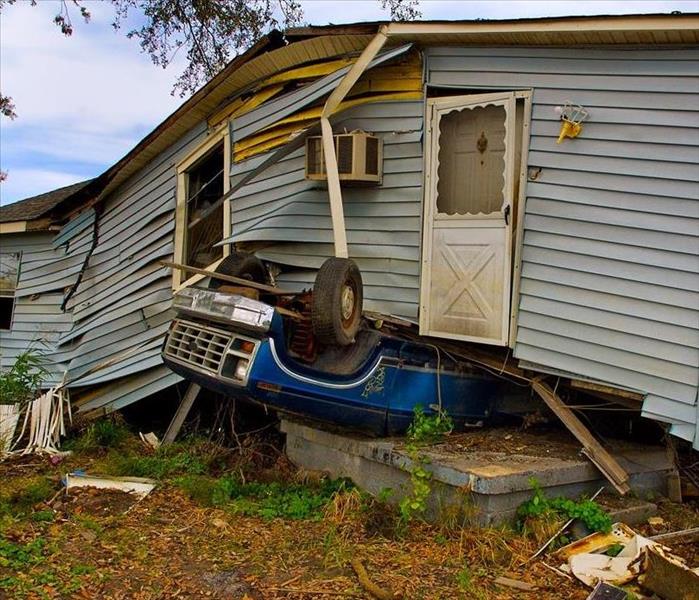 While this type of damage is atypical for this area severe damage is always possible
While this type of damage is atypical for this area severe damage is always possible
Hurricane season runs from June 1 to November 30. North Carolina’s coastline is vulnerable to hurricanes due to its position in the Atlantic Ocean. With all that, how does that affect Davidson County?
Depending on the path the storm takes our area could be hit with a wide a variety of weather. The biggest concerns for this region are devastating high winds, tornadoes, flooding and hail damage.
- High Winds: Tropical storm force winds can easily reach the triad and these winds are strong enough to knock down trees, powerlines, and even cause serious damage from flying debris.
- Tornadoes: Tornadoes are frequent byproducts of hurricanes. Many times, tornadoes are embedded in the rain bands that are well away from the eye. This means they could potentially strike well before the storm makes landfall.
- Flooding: Due to multiple rain bands that surround a hurricane this can cause widespread torrential rain which has the potential to last several days. This increases the risk of flooding, flash flooding, and falling trees. In fact, storm surge and flooding are the number one cause of death from a hurricane.
In conclusion, when people hear hurricane, they think of the coast, but the reality is we can get a lot of damage here locally as well. So, it’s very important to stay informed of the weather and have emergency supplies ready in the event a storm travels this way. And, remember if you do experience any damage from a storm let the experts at SERVPRO of Lexington / Thomasville help.
Is There a Tornado Alley in the Carolinas?
7/29/2019 (Permalink)
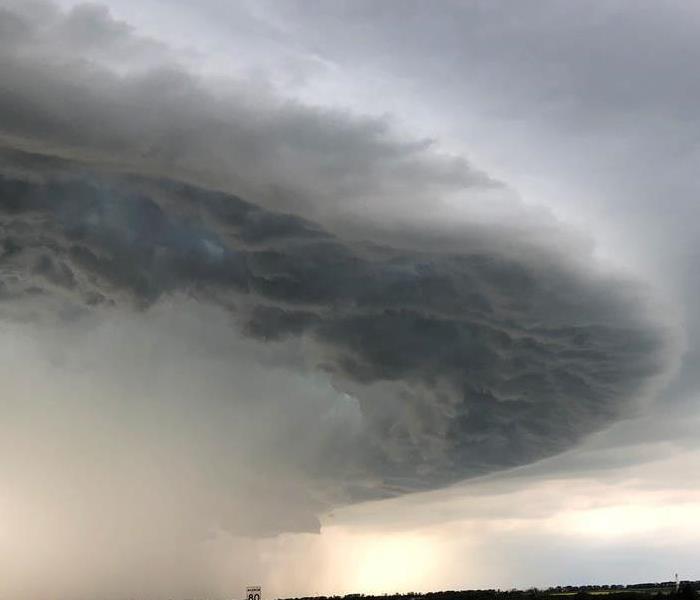 Photo by Randy Milanovic on Unsplash
Photo by Randy Milanovic on Unsplash
Living in the Piedmont area has many benefits. One of these benefits is that the Appalachian Mountains break up a lot of weather systems that can affect our region. That being said according to researchers at the University of Akron the fourth most active area for tornadoes occurs in “Carolina Alley”, which runs from northeastern South Carolina thru areas around the I-95 corridor in North Carolina.
North Carolina averages around 31 tornadoes a year. They can strike any time but generally occur from 3-9pm and most frequently during the month of May.
What Are The Warning Signs of a Tornado?
Unlike the plains which can see a tornado from miles away and have weather sirens, the piedmont relies heavily on local weather radar and eyewitness accounts. SO, what should you look for when there’s a threat of a tornado?
- Dark, often a greenish sky
- A wall cloud or an approaching cloud of debris
- Large hail often in the absence of rain A loud roar similar to a freight train
If you experience any of these conditions get into an interior windowless room or basement. Get under a sturdy piece of furniture and protect your head and neck with a blanket.
While tornadoes occur less frequently here than in the central US we all need to be prepared
Understanding Storm Risk Categories
7/17/2019 (Permalink)
Just like tornadoes and hurricanes NOAA (National Oceanic and Atmospheric Administration) has a category ranking for thunderstorms. Since thunderstorms are the most frequent type of storm event in our area an understanding of the risk categories is critical to ensure your safety.
There are six categories as recognized by NOAA’s storm prediction center:
THUNDERSTORMS-(Labeled in Light Green on their Chart). This category means general non-severe weather.
1-MARGINAL-(Labeled Dark Green on their Chart) Marginal risk means there could be isolated severe storms in your region but the duration and the coverage areas are limited.
2-SLIGHT- (Labeled Yellow on their Chart) Scattered severe thunderstorms are possible. They will usually be short lived, isolated and intense.
3-ENHANCED- (Labeled Orange on their Chart) Enhanced risk means a greater area of severe storm coverage is possible. It will be widespread and more persistent
4-MODERATE (Labeled Red on their Cart) This means widespread severe storms are likely and the duration of these storms can be long-lived.
5-HIGH (Labeled Purple on their Chart) These storms are long-lived and widespread. The risk of severe storms is high and most associated with a tornado outbreak
Understanding the severe thunderstorm risk category is important in keeping your family safe. For more information visit the National Weather Service at www.NOAA.gov.
Are you Ready for Summer Storms?
6/27/2019 (Permalink)
Summers in the piedmont of NC can run the gamut of hot humid day followed by afternoon severe weather. But many of its residents don’t consider the risk of damage from severe weather such as tornadoes or hurricanes. These storms hit with frequency ever summer These weather events can produce high winds, heavy rains which could leave massive damage in the are as well as knock out power or days at a time. Thar’s why it’s so important to have an emergency response plan ready for your home or business.
As SERVPRO of Lexington / Thomasville we offer free emergency response planning for businesses. Our ERP program is a great asset for any business who doesn’t have an emergency plan or give a business the option of mobility of a hand-held plan.
If you would like more information about our ERP program give us a call today at 336-224-2565.
Tips on Staying Safe During A Tornado
5/13/2019 (Permalink)
 Severe thunderstorms can the be precursor to a tornado.
Severe thunderstorms can the be precursor to a tornado.
Severe weather season is well underway in the Triad and many of us are out and about and enjoying the outdoors. So, what should you if you get an alert that there is severe weather in your area? Here are some tips to better understand and prepare for taking shelter during a tornado.
KNOW THE DIFFERENCE BETWEEN A WATCH AND A WARNING
- A Tornado Watch means conditions are favorable for producing tornadoes in your area. Watches are typically issued to cover large areas and can last for several areas. No tornado has been spotted and now is the time to prepare
- A Tornado Warning means a tornado has been sited or indicated on radar. This means there is imminent danger and you must seek shelter immediately. Warning areas typically cover a much smaller area and are shorter in duration.
KEEP CALM AND SEEK SHELTER
If a warning has been issued quickly move to your basement or a small windowless room on the lowest floor of your home. It is important to try to put as many walls between you and the outside as possible. Get under a sturdy table or in a bathtub and cover your head and neck with a heavy blanket, coat or if time permits a mattress. If you are in a mobile home, get out immediately and seek shelter elsewhere. Even if a mobile home is strapped down they are easily lifted by a tornado thus making them extremely dangerous. Go to a storm shelter or neighbors.
HAVE AN EMERGENCY SUPPLY KIT
In your “shelter area” keep a flashlight, first aid kit, extra shoes, weather radio and cell phone handy. For a more detailed list of emergency supplies click here.
DON’T DRIVE
Tornadoes are unpredictable. They can shift paths, speed up quickly and without warning. If you are caught in your car pull to the side of the road as quickly as possible. Leave your seat belt on and lower you head below window level and cover with whatever you can find such as a blanket or jacket. If there is a ditch which is noticeably lower than the roadway exit your car and lie in the ditch keeping yourself covered as much as possible.
By staying tuned to your TV, radio or weather app on your cell you can know what is happening and prepare to protect your family.
April Showers Bring May Storms???
4/12/2019 (Permalink)
The old adage April showers brings May flowers may be true but April and May also bring more risk of severe weather. April and May are generally the most active months in North Carolina for tornadoes. As well. Tornadoes strike quickly and with incredible velocity. Some tornadoes have been reported to have wind speeds of 300 miles per hours. They can uproot trees, tear structures off their foundations and make the most innocuous items into deadly projectiles.
What Can you Do To Protect Yourself?
The safest place for yourself and your family is a basement or s storm cellar. If that is unavailable an interior room on the lowest level is your next best location.
In addition to knowing where to go in the event of a storm having a battery powered weather radio is very important. The average warning time for a tornado is 13 minutes which means it is 13 minutes from the time the warning is issued to the projected landfall at your location. With only 13 minutes to seek shelter practicing your family’s tornado drill regularly will save critical time.
Finally, make sure you have a disaster / emergency kit prepared and stored in your shelter area. For more information on what you need to include in your kit please visit www.ces.ncsu.edu
When Winter Storms Hit Thomasville
1/25/2019 (Permalink)
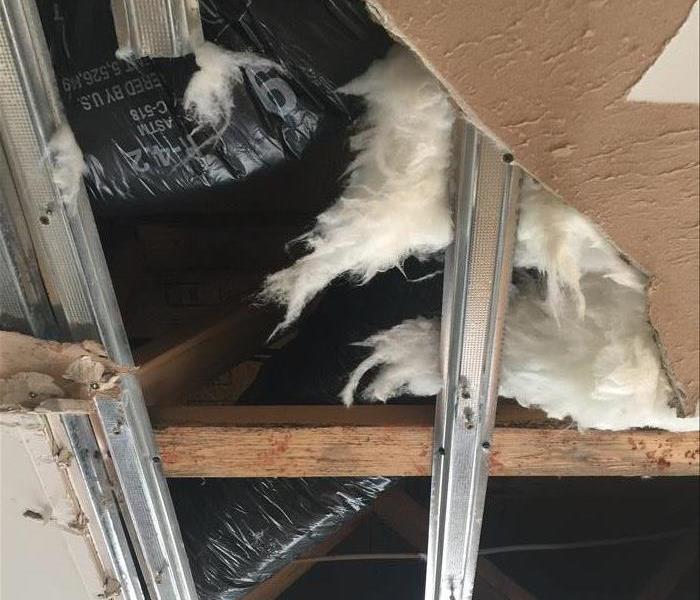 When a pipe froze in a second story apartment it damaged several units around it.
When a pipe froze in a second story apartment it damaged several units around it.
Weather in the Piedmont us unpredictable. That’s why it’s so important to know who to call when a disaster strikes. From frozen pipes to tornadoes and everything in between the professionals at SERVPRO of Lexington / Thomasville are here to help. With our no cost assessments and 24-hour emergency services, our team is the go to restoration company in the area.
And since we are locally owned and operated as well centrally located in Davidson County, we can respond faster to any disasters you may face in your home or business. From a small water leak to a catastrophic storm we have the team and equipment to get your home or business back to preloss conditions.
Finally, we offer free Emergency Response Planning. Our mobile ERP program is designed to help home and business owners gather and access critical information needed in an emergency and have it available at the touch of your fingertips.
If you would like to learn more about our Storm Response Team or ERP Program give us a call today at 336-224-2565.
Be Prepared for Winter Weather
12/12/2018 (Permalink)
When you think of storm preparedness ones first thought might be of hurricanes or tornadoes, but winter weather can be even more unpredictable. Fortunately, many of the same things you do to prepare for storms in the summer can be applied for your winter weather preparations.
In advance of the storm
- Stock up on food that needs no cooking or refrigeration. Be sure in your food stores you include food for pets, baby items and a can opener.
- Update/Replace your Emergency Kit Staples including: NOAA Weather Radio, extra batteries, first aid kit, extra medicine and cat litter or and for icy areas on sidewalks or driveways. Preplanning can help prevent you going out during the worse of the weather.
- Before the storm arrives make sure weather stripping, insulation and storm windows are In place. Clean out gutters and repair roof leaks. Unplug any hoses attached to your home. Inspect and clean fireplaces and inspect HVAC system.
- Finally, when preparing don’t forget your automobile. Having an emergency kit along with food, water and blankets can be critical if you are stranded during snow/ice event. Your car’s emergency kit should include:
- Cell phone, portable charger, booster cables, flares, tire pump, sand or cat litter for traction, flashlight, first aid kit, and plastic bags.
- Also, try to keep a full tank of gas and use deicing washer fluid in your windshield washer.
We can’t stop old man winter from coming but if you follow these suggestions you can be ready when he arrives. And after his arrival you find yourselves in need of emergency restoration services give SERVPRO of Lexington/Thomasville a call. With our 24 hour emergency services and no cost assessments we are the best choice for all your restoration needs.
Hurricanes: What You Need To Know
8/31/2018 (Permalink)
 Flooding is one of the many ways homeowners can be affected by hurricanes.
Flooding is one of the many ways homeowners can be affected by hurricanes.
Hurricanes are very powerful storms that form over the warm ocean waters. The Atlantic Hurricane Season runs from June 1 through November 30. The peak season is from mid-August to late October. According to readync.org North Carolina’s coast is one of the areas most open to direct hits due to our coastline extending further out into the Atlantic. Hurricanes not only affect coastlines, but their impact can be felt hundreds of miles inland. Some of the ways hurricanes can impact inland include but are not limited to flooding, high winds, severe thunderstorms and tornadoes.
Unlike tornadoes which usually only give you minutes to prepare, hurricanes can give you days even sometimes weeks to prepare. If particularly strong storm is expected to impact your community you must prepare your family for what could happen. Explaining the possible affect of the storm to your family especially your children can help ease anxiety. The next thing you should do prepare an emergency kit for each member of your family, including your pets. Your kit should include any medicines, food, water, flashlights, batteries, cash, a hand crank or battery-operated weather radio and any important documents such as insurance policies stored in a water tight container.
Know what to do when a hurricane strikes is critical to keeping your home and family safe. SERVPRO of Lexington/Thomasville offers free emergency response planning at https://ready.SERVPRO.com/
September is National Preparedness Month Are You Ready for Whatever Happens to Your Business?
8/24/2018 (Permalink)
Disasters and the resulting business interruptions the events cause can do more than just interrupt your work day. According to the US Department of Labor nearly 40% of businesses will never reopen after a disaster in the workplace. That percentage jumps to over 50% if you include catastrophic storm damage to the equation. No one plans on an emergency but with SERVPRO of Lexington / Thomasville’s free Emergency Readiness Program or “ERP” you can prepare for one.
Why create an ERP?
Planning ahead speaks to the trust clients and employees have in your business and by preparing for an emergency it shows those same people the importance you place on them and you can demonstrate how serious you are in protecting what matters.
Our free mobile app focuses on response and recovery of your business thus makes it a perfect compliment to any other plan you may have in place. A timely response during an emergency situation can minimize business interruptions associated with loss revenue and save you thousands of dollars in secondary damage. How can something free do all that you ask? The SERVPRO ERP complies all the critical information you would need in an emergency and has it available to you at the touch of your fingertips.
If you are interested in learning more about SERVPRO of Lexington / Thomasville’s ERP Program give us a call at 336-224-2565 and schedule your appointment today.
Recognize flood damage before purchase
8/13/2018 (Permalink)
According to the Centers for Disease Control and Prevention, flooding is one of the more common types of natural disaster across the globe. In fact, 40 percent of all disasters around the world can be attributed to flooding. Flooding causes deaths and millions of dollars worth of property damage each year. So, if you're in the market for a big ticket item such as a car or home knowing what to look for is critical before you sign on the dotted line.
After a particularly damaging storm, an influx of used cars may be available for purchase. It's often up to buyers to ensure they aren't purchasing a vehicle with water damage. Recognizing whether a car or truck has been damaged by flooding is not always easy and can take a trained eye. However, certain indicators can alert prospective buyers that a vehicle was once submerged in water.
* Excessive rusting: Certain parts of a vehicle's undercarriage will rust over time, especially after exposure to weather and salt products used on roadways to combat slick surfaces. But excessive rust or flaking metal that would not normally be associated with a late-model vehicle suggests water damage. While examining the undercarriage, look for sediment, mud and plant matter that may indicate the car was once submerged in water.
* Discolored carpeting: Check for water stains on mats, on carpeting and throughout the interior of the vehicle. Another warning sign is a used car with brand new upholstery, which may indicate the interior of the vehicle was replaced due to water damage.
* Strange odors: Water damage can make a car smell like mold and mildew, not unlike a musty basement.
* Fogging or water droplets: Water damage often leaves condensation behind in headlights and taillights. Fogging or droplets of water where they don't belong may indicate water damage.
* Water lines: Inspect under the hood for evidence of water. Rising water may stain metal components or leave behind a noticeable line after receding.
If you are looking to purchase a car and suspect flood damage request your mechanic to review the vehicle and voice your suspicions. If you suspect the property you are looking to buy or rent has water or flood damage give us a call at 336-224-2565 for your no cost assessment.
Is Your Thomasville Business Ready for Whatever Happens?
7/18/2018 (Permalink)
Disasters and resulting business Interruptions can devastate Thomasville business. Did you know according to the US Department of Labor nearly 40% of businesses won’t reopen after experiencing a disaster in their work place? That percentage jumps to over 50% if you include catastrophic storm damage in the equation. While no one can plan on a disaster you can plan for one. By preparing now you can minimize business interruption and loss revenue. You may also save thousands of dollars in reduced secondary damage.
How Do I Make an Emergency Plan?
Fortunately, you don’t have to plan, we have done it for you. With SERVPRO’s Emergency Readiness Plan you can help minimize the amount of time your business is inactive by having an immediate plan of action. Our ERP plan you can help minimize the amount of time your business is inactive by having an immediate plan of action. This mobile based plan store critical information needed in the event of an emergency.
Why the SERVPRO ERP?
A no cost assessment of your facility.
This means there is no need to allocate funds, giving you a great value at no cost.
- It was purposely designed to contain only the critical information needed in the event of an emergency.
- It will only take a little time to complete, however it will save you a lot of time if ever needed.
- Establishes SERVPRO® of Lexington and Thomasville as your disaster mitigation and restoration provider.
- This gives you piece of mind that should you ever need cleanup or restoration services, you have a trusted local provider that will be there for you 24/7.
If you would like more information about the SERVPRO ERP plan or would like to schedule one for your facility give us a call at 336-224-2565.
Lexington Homeowner Thankful For Professionalism
6/14/2018 (Permalink)
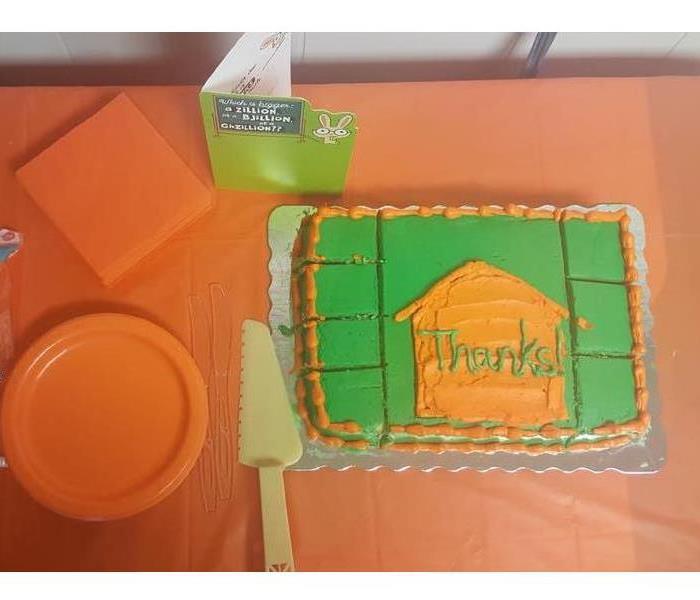 Homeowner bakes the SERVPRO of Lexington/Thomasville a cake to thank them for their service.
Homeowner bakes the SERVPRO of Lexington/Thomasville a cake to thank them for their service.
During the winter a Lexington homeowner was shocked to find icicles handing from the back of the property. During the cold a water supply line in the attic burst and flooded the all three floors of the property. The difficult part of this equation is the property owner was selling the Lexington home and living in Boone. She was overwhelmed at the prospect of trying to handle the restoration of the property while living two hours away but she trusted the professionals of SERVPRO of Lexington/Thomasville to get her property back to preloss condition and was thrilled with the results. Our team of trained professionals walked her through the process and kept her up-to-date on everything going on with her property. At each step of the process our homeowner was grateful she had chosen the right team for the job and in return she baked our team a cake to show her gratitude.
Staying Safe During Thunderstorms
4/17/2018 (Permalink)
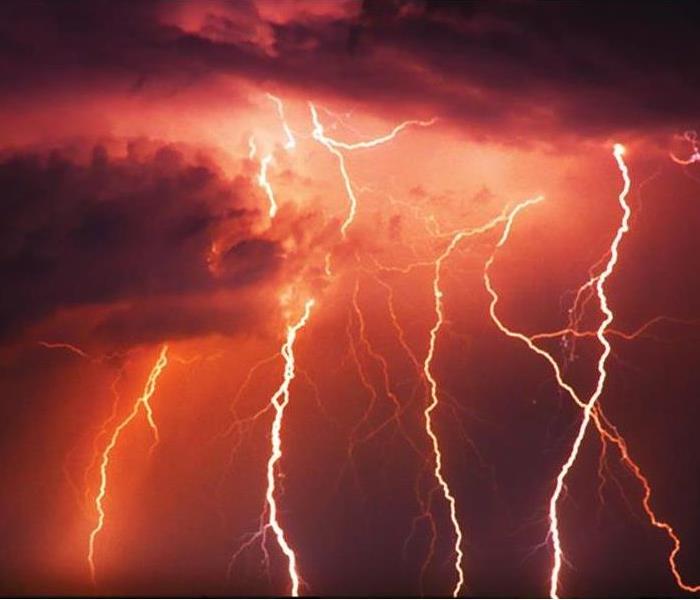 Watching a good storm can be an entertaining summertime activity.
Watching a good storm can be an entertaining summertime activity.
Few things grab our attention like a thunderstorm. Steamy temperatures and turbulent atmospheric conditions often conspire to produce amazing visual pyrotechnics and house-shaking booms. Thunderstorms occur when cold upper air descends and warm, moist air rises. When these air masses collide, they form thick cumulonimbus clouds, often referred to as 'thunderheads.' Thunderstorms may begin and end in an instant, or several storms may string together to make thunder and lighting clusters. While thunderstorms can occur during any time of the year, they're more likely to occur in spring and summer. According to a NASA study, the most intense and powerful thunderstorms occur in the eastern part of the Andes mountains in Argentina. But strong thunderstorms can occur just about anywhere moisture, unstable air and lift (from sea breezes or mountains) causes air to rise up. Thunderstorms have the potential to cause significant damage and injuries, most notably from lightning strikes. It's always wise to seek shelter during a thunderstorm so you are protected from lightning, falling limbs from trees and hail, which often accompanies thunderstorms. Despite thunderstorms' harmful potential, they can be very enjoyable to watch or chase. But storm spectators should keep these tips in mind.
Watch thunderstorms from the safety of indoors. It may be tempting to be out in the storm, but if you head outside during a storm, you are risking injury or even death. Consider watching a storm from the comfort of inside a garage, where you can leave the door open and see, hear and smell the storm while it comes through.
Keep flashlights or candles handy. Strong storms can knock out power. Always have a backup light source readily available in case the power goes out. Also, you may need a battery-powered radio or a charged mobile phone at the ready to keep up on storm alerts.
Keep pets in an interior room so they do not get too spooked. Thunderstorms frighten many animals, so pets should not share in your storm-watching endeavors. They may injure themselves trying to escape the noise. It's best if pets are kept in a quiet, dark space until the storm has ended.
Steer clear of standing bodies of water. Downed power lines may leach electricity through puddles, potentially causing electrocution if people are standing in puddles. Do not touch any wires that seem suspicious. Water is an easy conduit for lightning, so avoid any bodies of water during a thunderstorm.
If you're caught in a thunderstorm and don't have indoor shelter, do not seek shelter under trees, which can attract lightning strikes. Accuweather.com advises that people who cannot find reasonable shelter after a storm should take steps to minimize their risk of being struck or injured. Crouch as low to the ground as you can, but do not lie down on the ground or put your hands down. Stay on just your feet to cover as little ground as possible. You also want to be as low as you can to reduce your risks of being a lightning target. Keep anything that is a good electrical conductor away from you. Summer weather is bound to include some thunderstorms. Where there is thunder, there's lightning, and remember to stay safe by watching these storms from a distance and making smart choices.
Flooding Facts
2/1/2018 (Permalink)
Floods can be highly destructive natural disasters. The U.S. Geological Survey’s Water Science School says that around 71 percent of the Earth’s surface is covered by water. National Geographic points out that flooding has caused more death and destruction than any other kind of natural disaster in the United States. Flooding may result from overflowing streams or rivers; when coastal storms cause the sea to surge inland; if a dam or levee has ruptured; if ice melts rapidly in the mountains; or if excessive rain cannot be absorbed by the ground fast enough. Flooding can even occur without warning, and such instances are referred to as “flash flooding.” Staying safe during floods involves understanding floods. The following information, courtesy of the Emergency Management Institute, FEMA, Ready.gov, and National Geographic, can help men and women better understand floods and how to stay safe in flooding situations.
• No region is safe from flooding. Floods can occur anywhere, but are rare in areas where water is scarce.
• Floods may develop very slowly or in just a matter of seconds after an extensive rainfall.
• Areal floods can occur where saturated grounds are present.
• Although the term “hundred-year flood” describes an extremely large and very rare event, these types of floods have recently been occurring worldwide with increased regularity.
• In the United States, floods cause about $6 billion worth of damage and kill, on average, 140 people every year.
• Coastal flooding alone attributes to $3 trillion in damage worldwide.
• Flood waters can quickly knock people off their feet and carry them away.
• It’s important to sanitize oneself after coming in contact with flood water, which could be contaminated with various natural and manmade substances.
• It may be necessary to move to higher ground when flooding situations occur. It’s important to heed safety precautions and evacuation messages.
• Rapidly moving water has the potential to carry a house, car, trees, or other structures away. • Drivers should not try to navigate through flood waters. Many deaths that occur during floods happen when drivers try to move through flood waters.
• It’s imperative to keep an emergency kit, nonperishable food, flashlights, and batteries on hand to combat potential disasters like floods.
• Flood damage is not necessarily covered by homeowners insurance. Those who live in high-risk flood zones would be wise to purchase flood insurance to protect themselves. Floods can be formidable foes. Armed with information, people can be safer when the waters rise.
Prevent Frozen Pipes While Traveling
1/18/2018 (Permalink)
During winter, many people plan vacations to warmer climates so they can enjoy a relaxing respite from the snow and ice. While travelers are enjoying the sand and surf, their homes may be in danger from extreme weather conditions. According to the State Farm Insurance Company, frozen water pipes affect quarter-million families each winter. Both copper and plastic pipes can freeze. State Farm notes that a single 1⁄8-inch crack in a pipe can result in up to 250 gallons of water leakage per day. Flood water can contribute to serious structural damage, mold and a host of other problems. Water expands as it freezes, so pipes can be put under strain if the pressure from expanding water has nowhere to go, offers the American Red Cross.
Pipes that tend to freeze most frequently include those exposed to severe cold, such as outdoor hose bibs, swimming pool lines and water sprinkler systems. However, even pipes inside a home, such as those in unheated areas or those that run against exterior walls, can freeze. To avoid returning from a relaxing winter escape to find a home in need of repair thanks to frozen pipes, homeowners can take these steps.
• Add insulation to attics, basements and crawl spaces to help maintain higher temperatures within the areas where some water pipes may run.
• Pipes themselves can be insulated with special coverings or sleeves. Homeowners also can explore heat tape or wrap pipes in heat cables controlled by their thermostats.
• Disconnect outdoor hoses, and drain water from pipes leading to outdoor faucets. Turn off the indoor valve to shut off the water supply to the outdoors, but leave the outdoor bib in the “open” position to allow water to drip and relieve pressure should some freezing occur.
• The same technique can be applied indoors. A trickle of hot and cold water can keep pipes from freezing during extremely cold snaps of weather. • Set the thermostat to a consistent temperature, ensuring that the temperature indoors will not drop dramatically overnight. The temperature should be no less than 55 F. • Open cabinet doors to allow heat to reach under sinks and appliances. • Check around the house for drafty areas that can contribute to colder temperatures in garages, basements and crawl spaces.
And remember if your home or business does experience a loss due to a frozen pipe call the professionals at SERVPRO of Lexington / Thomasville. We are here to help.
Warning signs of disaster scams
9/15/2017 (Permalink)
When natural disasters strike such as Hurricane Harvey and Irma, many people immediately ask what they can do to help. Some may volunteer at disaster sites, while others may offer financial donations from afar. While donors'efforts are always sincere. Fraudulent websites, bulk email solicitations and texting scams that encourage donations are each means by which criminals take advantage of conscientious donors. As eager as prospective donors may be to lend a financial hand when disaster strikes, it's important to take the time to confirm that an organization is legitimate and not an operation organized by fraudsters looking to make a fast buck. Research the organization before donating. If they are asking for personal information such as social security numbers or using high pressure tactics this may be an indication of a scam.
Other scammers may stop by and knock on doors and promise to restore property and contents immediately if you can pay upfront. This should be an immediate red flag. Do not ever hand over payment before work begins. Legitimate contractors and restoration companies will walk you through to process and have you sign a contract explained exactly what work will be done and the payment agreements. Also, ask for references or contact the BBB and make sure they are a reputable company.
Flooding
9/1/2017 (Permalink)
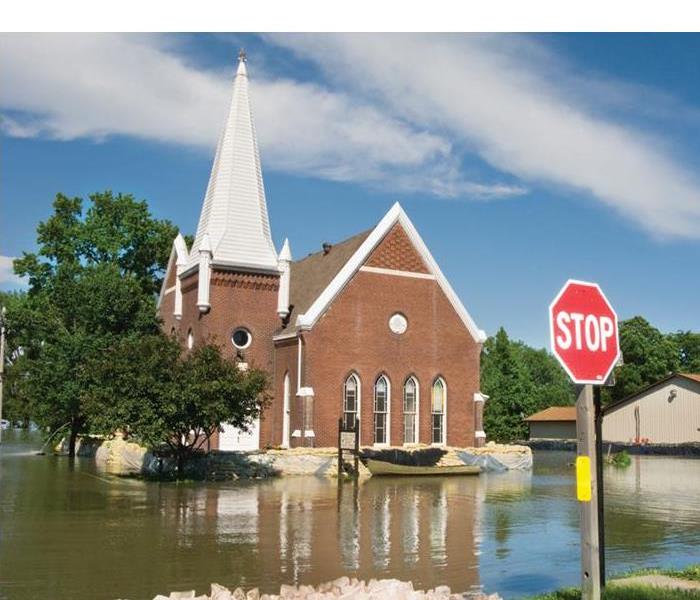
According to the National Oceanic and Atmospheric Administration, flooding is becoming more frequent along the coastlines of the United States. Studying measurements from tide gauges at locations along U.S. coasts, the NOAA found that nearly every site measured has experienced an increase in coastal flooding since the 1950s. The mid-Atlantic region experienced the highest number of coastal flood days and also the largest increases in flooding from 1950 to 2015. Since 2010, no area has flooded more often than Wilmington, North Carolina, which flooded an average of 49 days per year. The United States Environmental Protection Agency notes that higher sea levels pose a number of threats to coastal communities, including making coastal infrastructure more vulnerable to damage from storms because that infrastructure was not designed to withstand frequent inundation or exposure to salt water. Coastal flooding, the EPA notes, also can affect human health by increasing the risk that drinking water and wastewater infrastructure will fail, potentially exposing people to pathogens and harmful chemicals.
But flooding is not exclusive to coastlines or waterway. Flash flooding, hurricanes, and prolonged rainy season cans affect any property not just those in a flood plane. Knowing this having a conversation with you insurance provider to determine what is and isn't covered in your policy will help prepare you in the event that this happens to you.
September is National Preparedness Month
9/1/2017 (Permalink)
SERVPRO of Lexington/Thomasville realizes no one plans on being affected by a disaster but we can help you prepare for one. September is National Preparedness Month and we want to help you prepare your home and business for whatever comes your way.
The first step in your planning process is to determine what type of disasters your plan will cover. You may want to begin with the most common type of situation in your area such as flash flooding or tornadoes. Know how to contact each member of your family throughout the day in the event of an emergency situation is critical as is establishing a family meeting place. Having a clear thought out plan can save time which could be critical.
Next thing to consider is a list of the supplies each family member (both two and four legged) needs specifically for their daily living needs. Remember to include medications, water, sanitary supplies such as diapers and wipes. If you are storing canned food remember to pack a manual can opener. A weather radio and extra batteries are important if this is a slow moving event.
If this still seems a bit overwhelming, SERVPRO offers and free mobile based emergency response plan or “ERP” that can help you begin the process. The app is free and can be downloaded for any android/iphone mobile device. We even offer to complete these profiles for free for businesses. Having a plan in place can’t prevent a disaster from occurring but preparing for one can help you get back to your life much more quickly.
Severe Weather Can Affect Your Thomasville Home
7/20/2017 (Permalink)
Living in the heart of the Triad has its benefits but is has its drawbacks as well. While we can drive to the coast or the mountains in a couple of hours we can also experience the same types of damage as those regions as well. Hurricanes, tornadoes, major snow storms and ice events are just of the few catastrophic storms our region can face. That’s why it’s so important to have a name you can trust when storm damage hits your Thomasville home. No matter how your home is damaged from a storm, SERVPRO of Lexington/Thomasville is prepared to respond to your emergency with best practices, advanced gear, and with the goal to ease your mind and get you back into your home as soon as possible.
Understanding the Hazards After a Storm
The National Weather Service is constantly at work trying to create a better warning system for thunderstorms, tornadoes, hurricanes, flooding and other natural disasters that can affect our region. While warning times have steadily increased to help people take the step to protect their family and property knowing who to call after the storm hits your Thomasville home or business is critical. That’s why SERVPRO of Lexington/Thomasville are the professionals you know and trust. As a family owned and operated business we have a stake in this community. We not only work here but live here as well so we know we will be working with our friends and neighbors. Unlike other restoration companies we pride ourselves of being life long residents of this community and know the value of calling Davidson County home.
Severe storms can cause a number of issues such as flooding, fallen trees, tornadoes, and even hurricanes that come in from the coast. While you cannot prevent the storms from impacting your region there are things you can do to respond if a crisis like this occurs. Keep an eye on the weather. Some storms such as major winter events and hurricanes are slow moving and can give you time to prepare your home for the upcoming event. Other things like tornadoes and severe thunderstorms strike with out warning. With our 148 Guidelines we can be on site within hours. Our guidelines are as follows:
148 Emergency Response Guidelines:
1– Within one hour from notice of loss, a SERVPRO Franchise Professional will contact your Insured to arrange for service.
4– Within four hours of loss notification, a SERVPRO Franchise Professional will be on-site to start mitigation services (if necessary).
8– Within eight business hours, a verbal briefing of the scope will be communicated to the adjuster by a SERVPRO franchise Professional.
Contact Us
If your home or business experiences a loss due to storm damage, contact SERVPRO of Lexington/Thomasville at (336) 224-2565. No matter what type of damage your home has been affected by, you can count on our specialists to respond to your emergency. With our 24-hour emergency service we are here to help any day, any time.
How to protect a coastal property
7/17/2017 (Permalink)
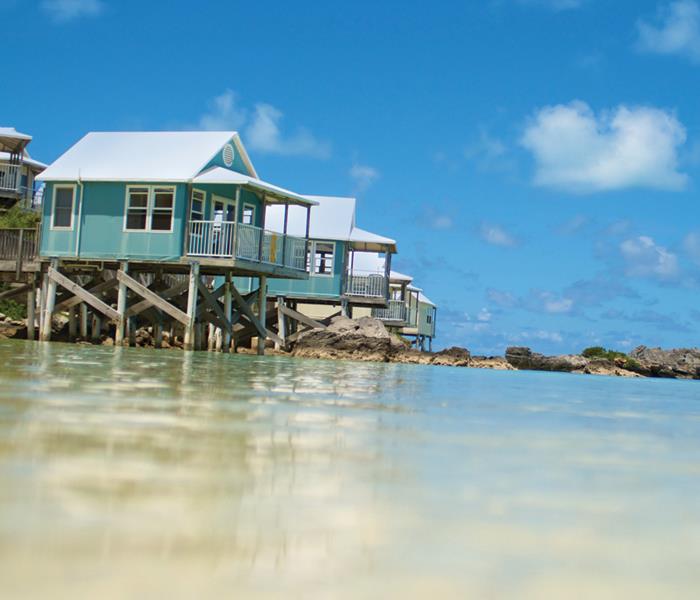
Many people dream of owning coastal properties. Some aspire to have a home away from home for vacations or long weekends, while others move to the coast to be nearer to family or when they reach retirement age. Living close to the water can be relaxing, and it's hard to beat the fresh air and the relaxing sound of the waves. However, coastal homes require some unique upkeep that prospective buyers should familiarize themselves with before buying a property. Salt water Salt buildup is one of the pitfalls of living close to the ocean. Salt is corrosive to metal components, so homeowners are advised to avoid metal parts in various areas of construction on their homes. Windows and doors are particularly at risk because they face the constant onslaught of Mother Nature. Fiberglass, vinyl and aluminum are less corrosive than other metal parts and should be considered in window framing. Homeowners may need to apply lubricant to moving parts, locks and fasteners to keep them moving smoothly. Consult with a lawn and garden expert about which coastal plants thrive with high levels of salt in the air. Professionals can make recommendations on low-maintenance landscapes that will not be damaged by the sun and salt. Humidity and salt concentrations also can cause concern indoors. Mold likes damp, dark conditions, so homeowners should do their best to keep their homes dry and well-ventilated. Rely on dehumidifiers to take moisture out of the air. Install more vents to draw air outside and create fresh air flow. Coastal flooding Coastal flooding is another concern for homeowners who live close to the water. Prospective buyers should first determine if the house they want to buy is in a flood zone or an evacuation zone. This is information that may come up when applying for homeowner's insurance, as flood insurance is a separate policy. Individuals may have to take special measures to protect their homes from incoming tides or high waters during storms. The National Flood Insurance Program provides a flood damage simulator to predict the total cost of flood repair based on the height of the water. For one to four inches of water, the estimated repair cost is $7,800. For nine to 12 inches, the estimate is $18,930. At 18 inches, the estimated cost is $26,285. Homeowners may want to invest in lifting their homes or taking other preventative measures if coastal flooding is common. Privacy and safety Living by the ocean can be great, but coastal towns are often a magnet for tourists. Homeowners with seaside homes or homes in popular tourist areas may want to take extra steps to create privacy and security. Fencing and natural windblocks can block the view of backyards and other outdoor spaces. An alarm system can offer peace of mind in areas close to resort towns. Adequate lighting can deter trespassers as well. Living by the ocean is a dream for many people. The increased upkeep required on a coastal home is often a small price to pay for such luxury, but it's something prospective buyers should consider before buying a home.
Severe Weather Preparedness Week
3/3/2017 (Permalink)
 Mammatus Clouds are most often associated with anvil clouds and also severe thunderstorms.
Mammatus Clouds are most often associated with anvil clouds and also severe thunderstorms.
Severe Weather Preparedness Week is March 5-11, 2017 and marks the unofficial start to severe storm season in the state although tornadoes and thunderstorms can strike any time of the year. During this time of the year most people in Davidson County associate severe weather with Tornadoes. A tornado is a violent windstorm characterized by a twisting, funnel-shaped cloud. It is spawned by a thunderstorm or a hurricane. Tornadoes occur when cool air overrides a layer of warm air, forcing the warm air to rise rapidly. The damage results from high wind velocities and wind-blown debris. They can strike with incredible velocity. Wind speeds may approach up to 300 miles per hour. These storms can uproot trees, destroy structures and turn harmless objects into deadly missiles, all in a matter of seconds.
We average of 31 tornadoes in our state while the plains and the deep south are the states at greatest risk.
Staying informed is the way to be prepared and stay safe and the best way to stay informed is with a weather radio. Families should also have an emergency kit of essential supplies as well as a family communication plan. To learn more about what to include in your emergency kit as well as how to build a family communication plan visit https://www.ready.gov/tornadoes
Lexington Homeowners Concentrate Efforts On Preparations To Battle Storm Damages!
1/18/2017 (Permalink)
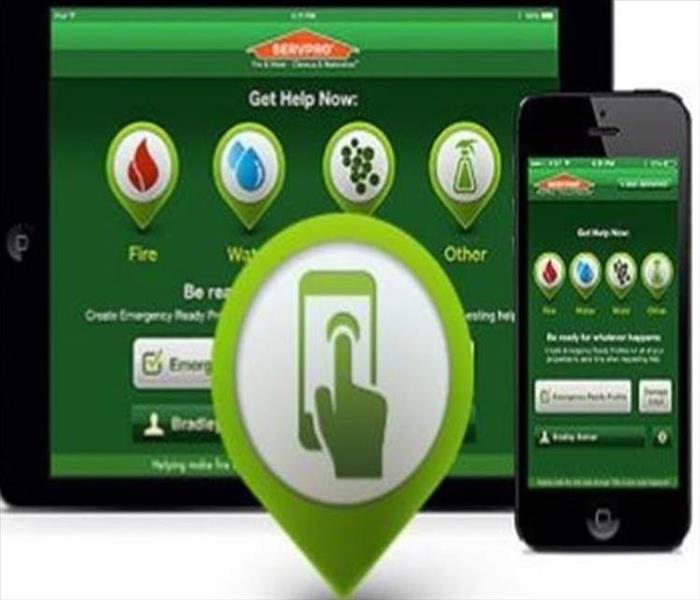 SERVPRO Helps Prepare and Prevent Storm Damage to Your Lexington Home
SERVPRO Helps Prepare and Prevent Storm Damage to Your Lexington Home
SERVPRO Offers Advise and a Software Program--ERP--to Mitigate Storm Damage
A series of torrential downpours, followed by hurricane-force winds, swept through the surrounding area over the last week. Homes of all shapes and sizes succumb to flooding, leaving homeowners stranded, seeking assistance with repairs to their homes.
Prepare yourselves and your homes in Lexington, to battle possible storm damage. It can be the most valuable thing you do, but hardly the most expensive. Ensure that you have the mindset of preparing for the worst, yet, hoping for the best.
At SERVPRO we would like to recommend you checking a few things off ahead of time, take a relatively proactive approach to protecting your family home this hurricane season. Start by investing in a proper insurance policy to cover the full cost of rebuilding, storm damages and especially, flooding. Have a professional survey performed on your home, tally the value of your possessions each year, so that you have a complete list of your valuables and know exactly how much your home is worth. Ask SERVPRO to visit your property and set up our ERP mobile app to provide contact information, relevant infrastructure information, and an immediate action plan to mitigate losses from fire, water, or storms.
Invest in the item with the largest potential of causing terrible damage to your home, your roof. Have your roof properly inspected, add water sealing where possible and even check into the installation of roof straps, if you can access your roof through your attic. When you have missing or damaged tiles or shingles, you offer wind and water a rather large opening to wreak havoc on your home. Contact your insurance company to see if you qualify for wind mitigation premium reduction.
Take the time to have a qualified professional inspect various areas of your home for integrity, if you have a porch, carport, or other structure hanging off the side of your house that looks like a wing, that is what it will act like during a storm. Potentially ripping the side of your house off, it is better to have these structures firmly anchored to the ground.
Have a qualified professional, like those offered at SERVPRO, inspect all door and window seals; this can help prevent side-winds from blowing rain directly into your home. While also looking into having sump pumps and any necessary drainage installed to assist with avoiding flooding where possible.
When you know, winds are approaching gale-force strength, check the areas around your home of any potential projectiles. The grill, lawn furniture, and even garden gnomes qualify here, store them indoors or secure them to the ground until the crisis has passed. If you have a garage, these doors are rather flimsy. Reinforce your existing door by installing a vertical garage door brace and horizontal wooden beams to protect it against high winds.
Contact our offices at SERVPRO of Lexington / Thomasville today for additional insight and information on available services. (336) 224-2565





 24/7 Emergency Service
24/7 Emergency Service













